Meeting of the Hawke's Bay Regional Council Maori
Committee
Date: Wednesday 3 November 2021
Time: 10.00am
|
Venue:
|
Council Chamber
Hawke's Bay Regional Council
159 Dalton Street
NAPIER
|
Agenda
Item Title Page
1. Welcome/Karakia/Notices/Apologies
2. Conflict
of Interest Declarations
3. Alternate Member
for 3 November 2021 Meeting 3
4. Confirmation of Minutes of the Māori Committee held on 11
August 2021
5. Take Ripoata
ā Takiwā – Taiwhenua Representatives' Updates 5
6. HBRC Chair and Chief
Executive's Verbal Updates on Current Issues
7. Follow-ups from
Previous Māori Committee Meetings 47
8. Call for Minor
Items Not on the Agenda 51
Information or Performance Monitoring
9. Public Use of
Rivers 53
10. Possom Control Area - Partial
Regional Pest Management Plan Review 57
11. Coastal Bird Survey Results 61
12. LiDAR Partnership Programme
Follow-up 65
13. Reports from Regional Council
and Committee Meetings 67
14. October 2021 Statutory
Advocacy Update 73
15. Significant Organisational
Activities Looking Forward through November 2021 79
16. Verbal End of Year Review
17. Discussion of Minor Items not
on the Agenda 89
Parking
1.
Free 2-hour on-road
parking is available on Vautier Street adjacent to the HBRC Building & on
Raffles Street.
2.
There is free all day
parking further afield – on Munroe Street or Hastings Street by Briscoes.
3.
There are limited
parking spaces (3) for visitors in the HBRC car park – entry off Vautier
Street – it would be appropriate that the “visitors” parks be
available for the members travelling distances from Wairoa and CHB.
4.
If you do pay for
parking elsewhere, please provide your receipt to the Receptionist for
reimbursement – or include with your expenses claim for the meeting.
NB: Any carparks that have
yellow markings are NOT to be parked in please.
HAWKE’S
BAY REGIONAL COUNCIL
Māori
Committee
Wednesday 03 November 2021
Subject: Alternate Member for 3
November 2021 Meeting
Reason
for Report
1. The Māori
Committee Terms of Reference makes allowance for short term replacements
(proxy) to be appointed to the Committee where the usual member/s cannot
attend.
Recommendation
That __________________ be
appointed as a member of the Māori Committee for the meeting of 3 November 2021 as a short
term replacements on the Committee for ____________.
Authored by:
|
Annelie Roets
Governance Advisor
|
|
Approved by:
|
Pieri Munro
Te Pou Whakarae
|
|
HAWKE’S
BAY REGIONAL COUNCIL
Māori
Committee
Wednesday 03 November 2021
Subject: Take
Ripoata ā Takiwā – Taiwhenua Representatives' Updates
Reason
for Report
1. This item
provides the opportunity for representatives of the four Taiwhenua (Te
Whanganui-a-Orotū, Tamatea, Wairoa/Kahungunu Executive and Heretaunga) to
raise current issues of interest in their rohe for discussion as per the
reports attached.
Decision Making Process
2. Staff have
assessed the requirements of the Local Government Act 2002 in relation to this
item and have concluded that, as this report is for information only, the
decision-making provisions do not apply.
Recommendation
That the Māori
Committee receives and notes the “Take Ripoata
ā Takiwā – Taiwhenua reports”.
Authored by:
|
Annelie Roets
Governance Advisor
|
|
Approved by:
|
Pieri Munro
Te Pou Whakarae
|
|
Attachment/s
|
1⇩
|
Te Taiwhenua
o Tamatea report
|
|
|
|
2⇩
|
Te Taiwhenua
o Heretaunga report
|
|
|
|
3⇩
|
Wairoa
Taiwhenua Report and presentation
|
|
|
|
Te
Taiwhenua o Tamatea report
|
Attachment 1
|




|
Te Taiwhenua o Heretaunga
report
|
Attachment 2
|

|
Wairoa
Taiwhenua Report and presentation
|
Attachment 3
|









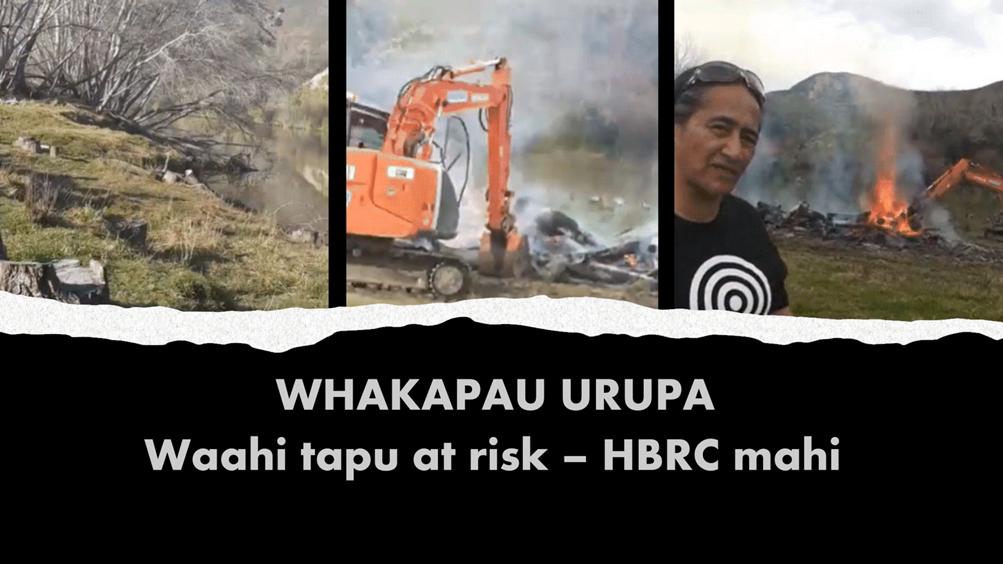
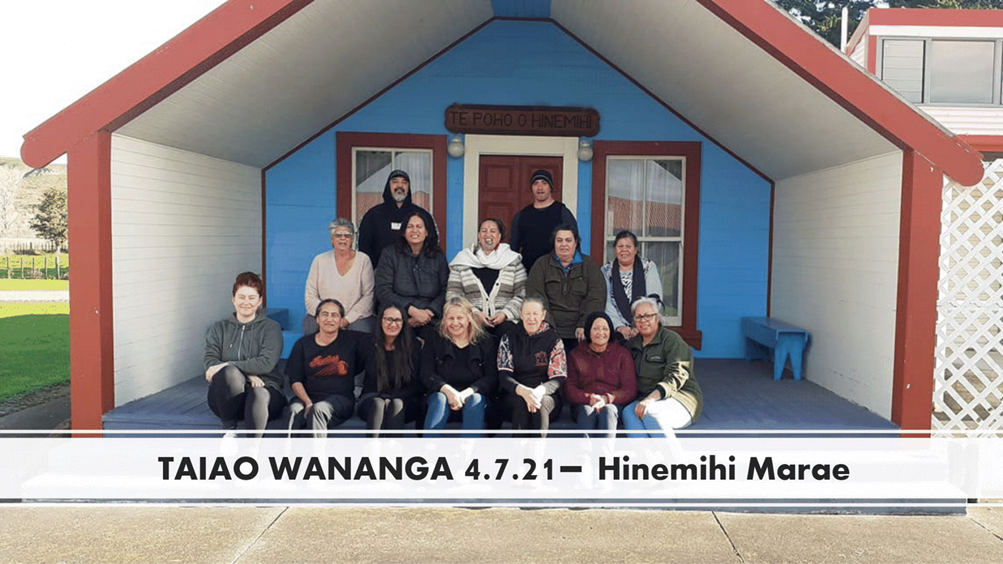
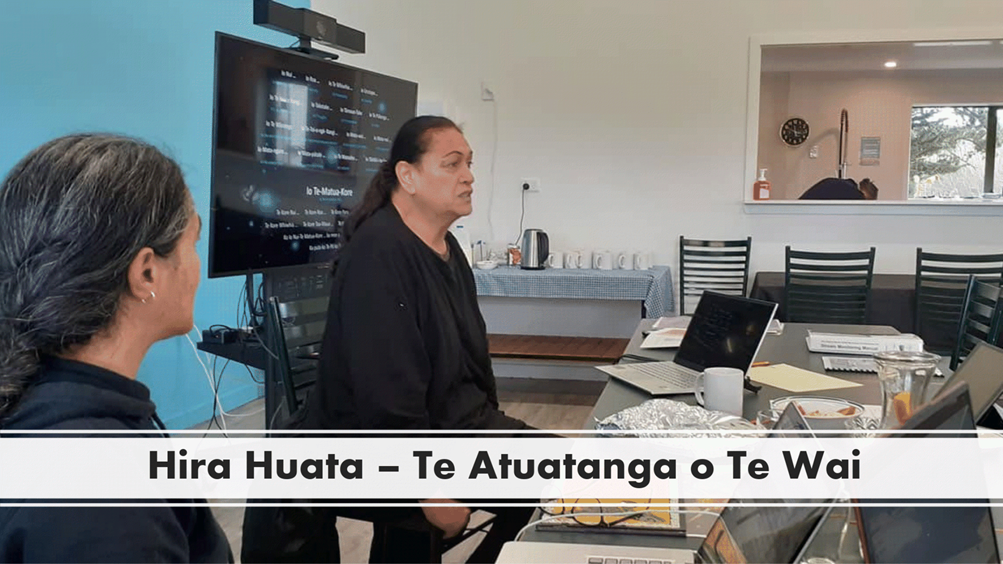
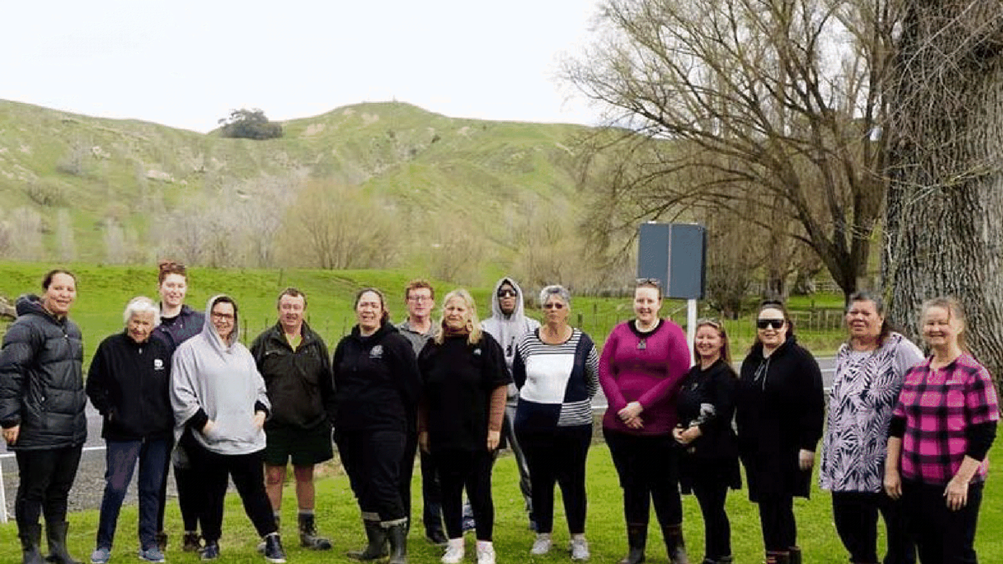
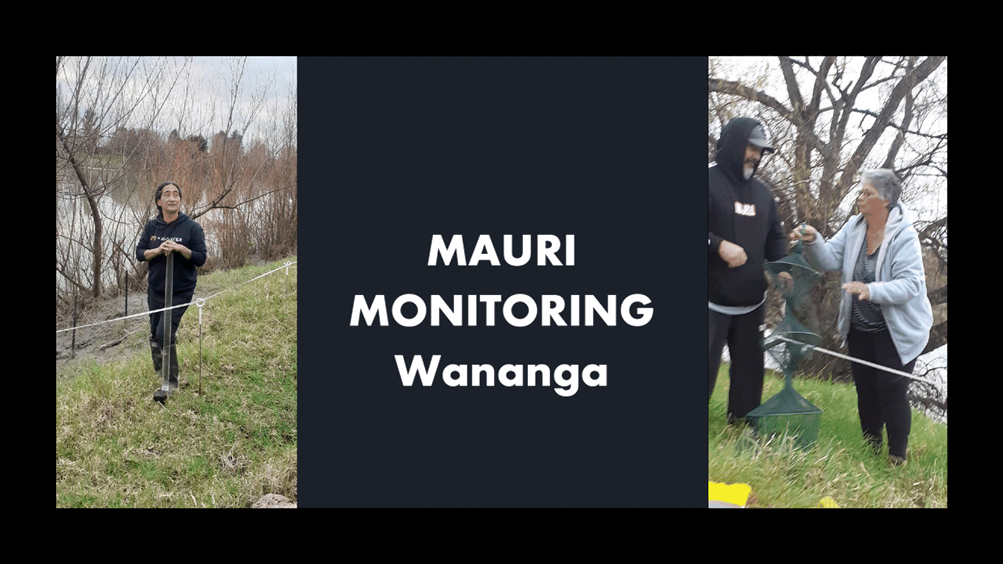
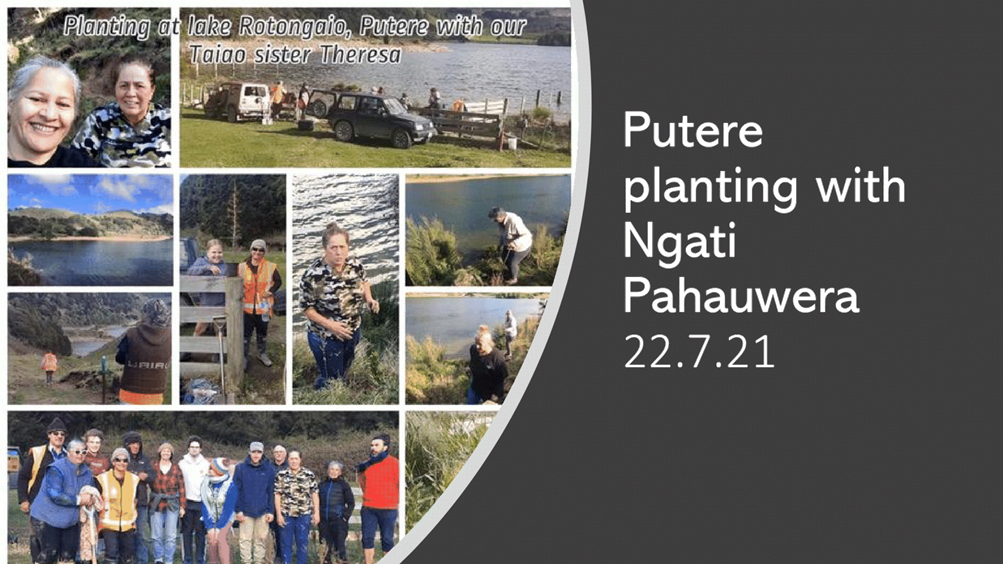
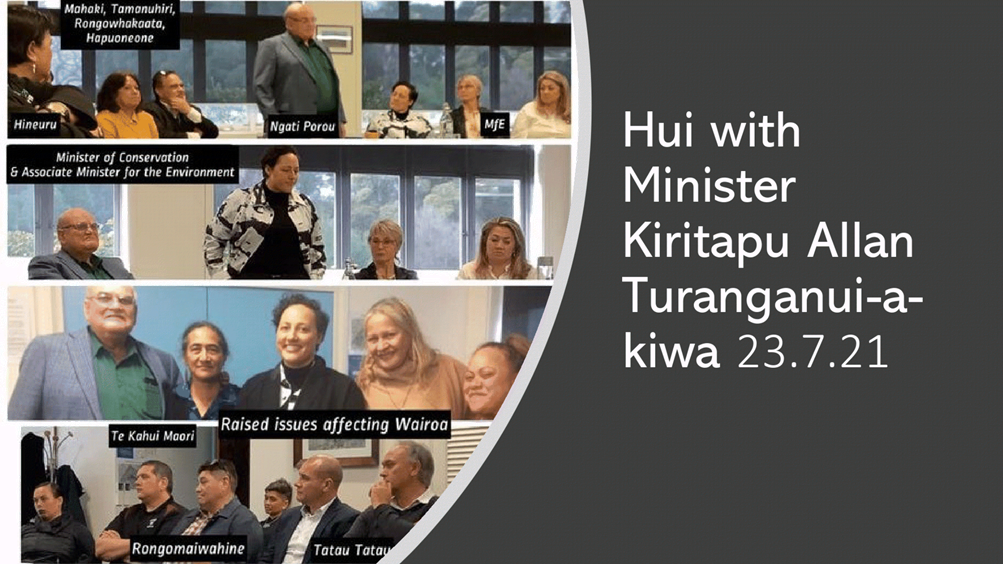
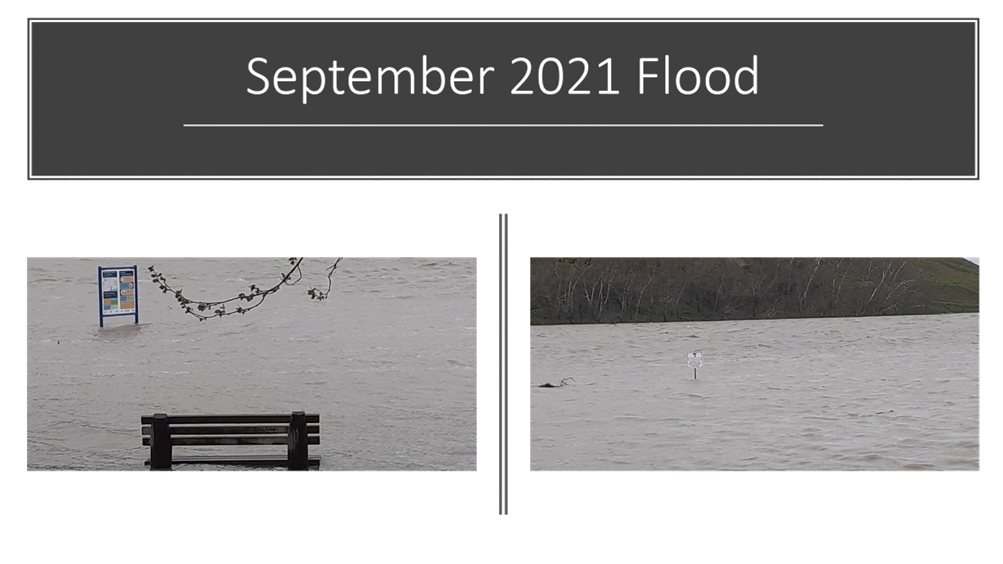
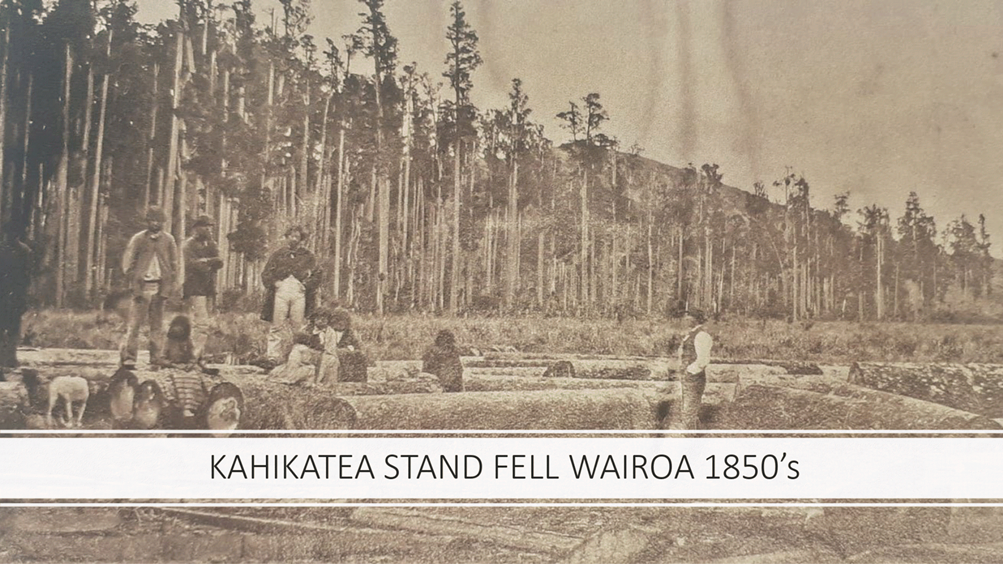
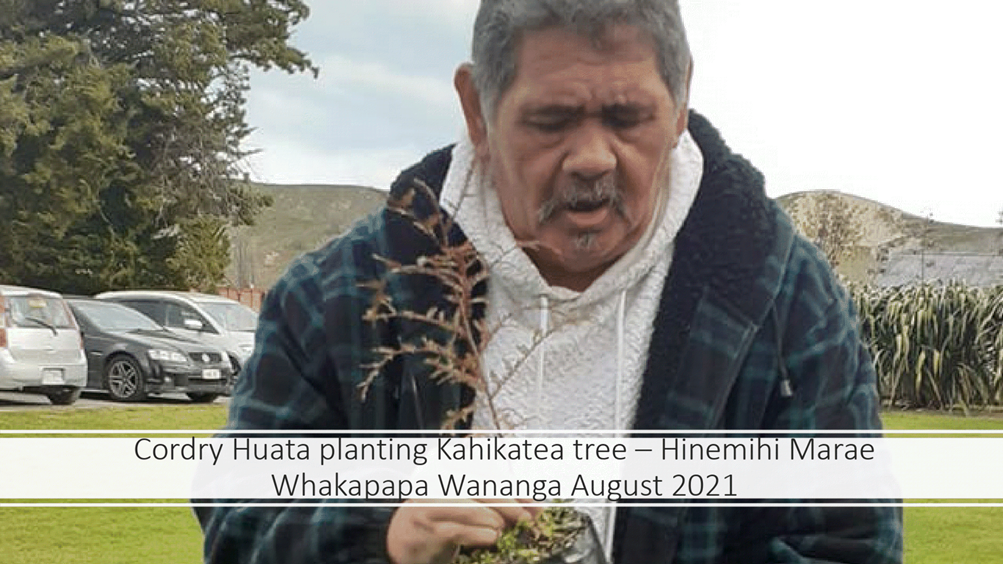

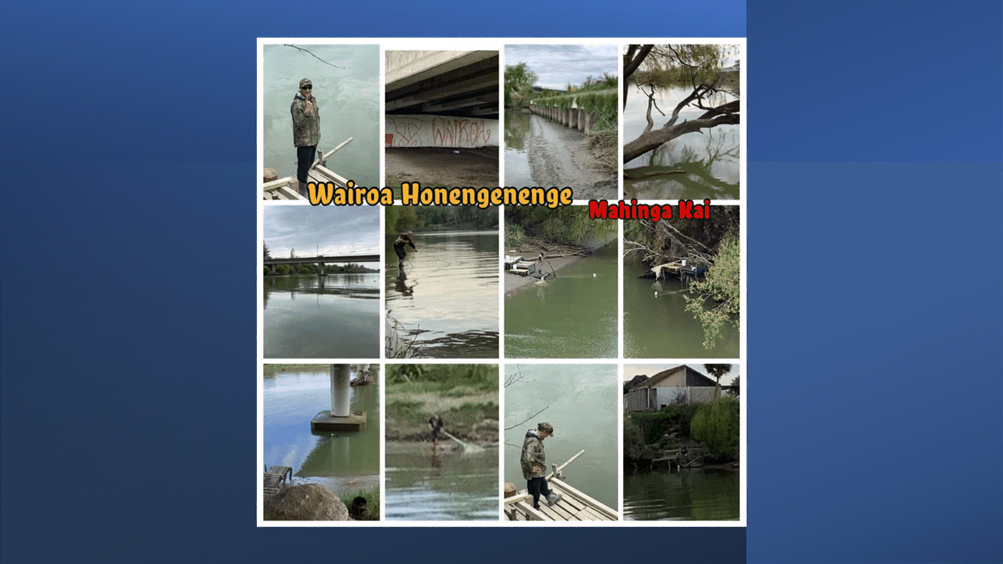
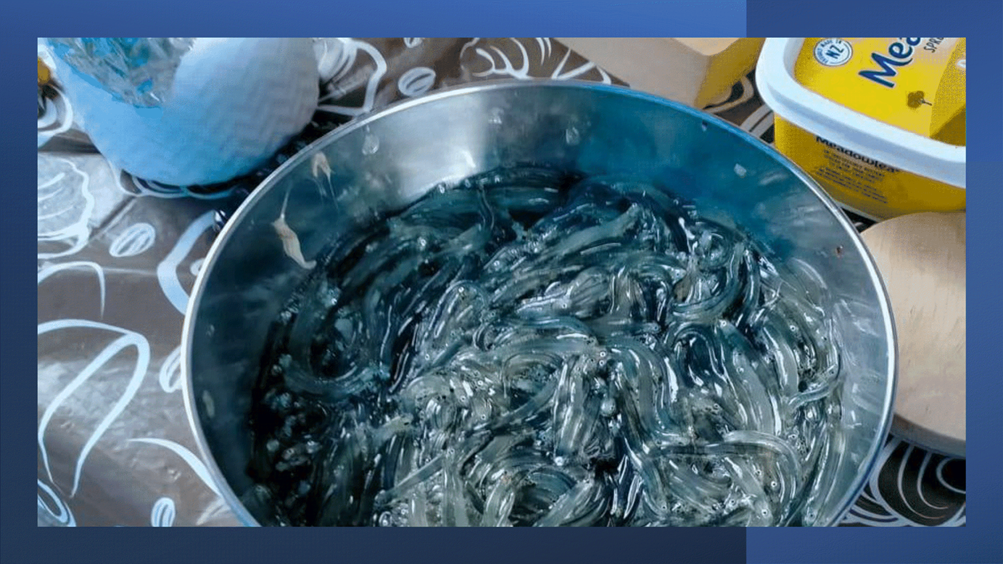
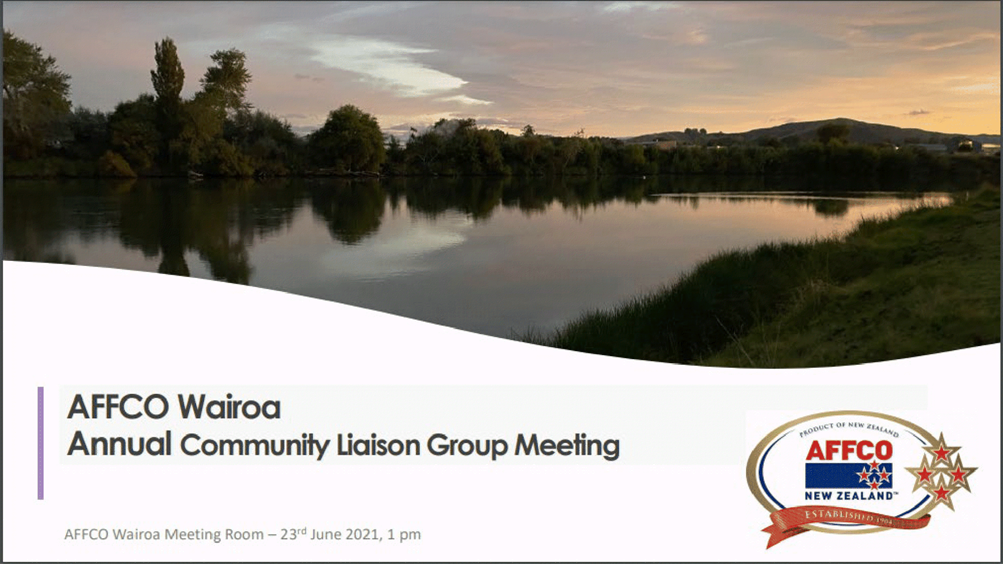

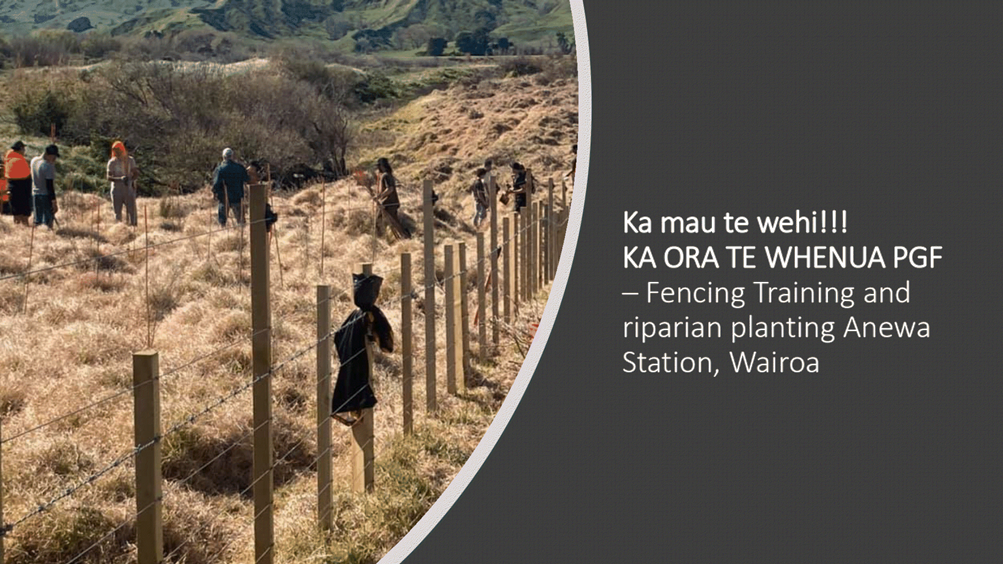
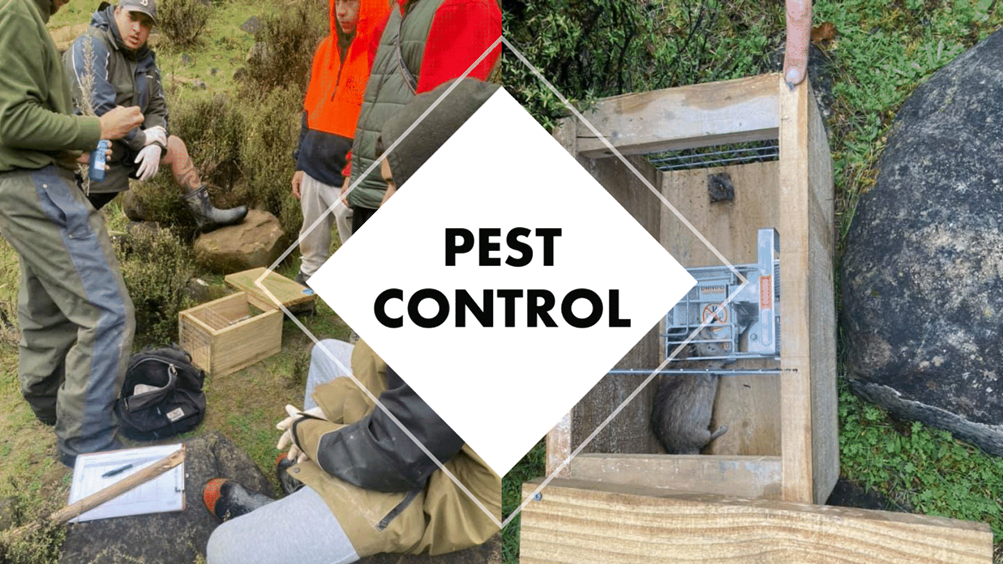
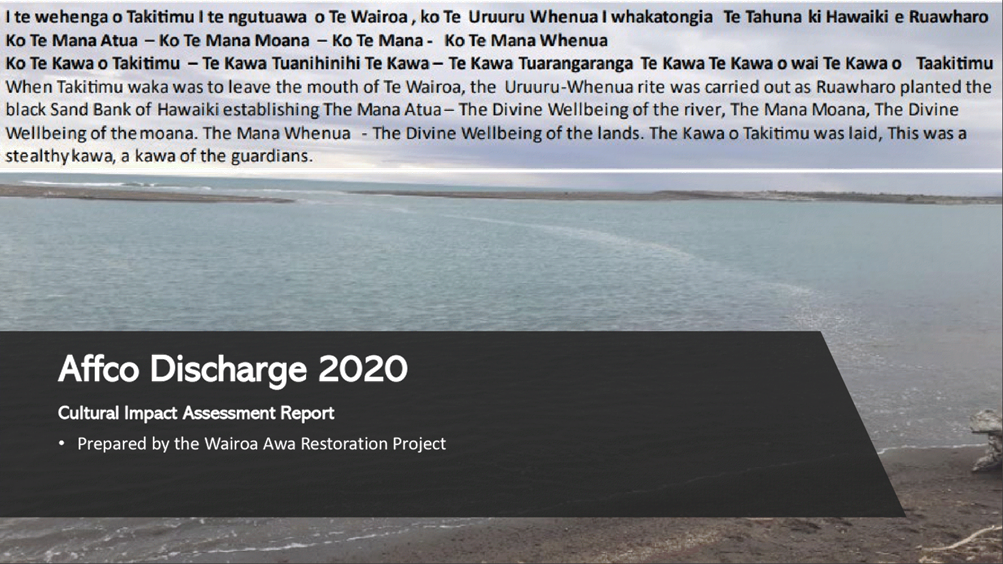
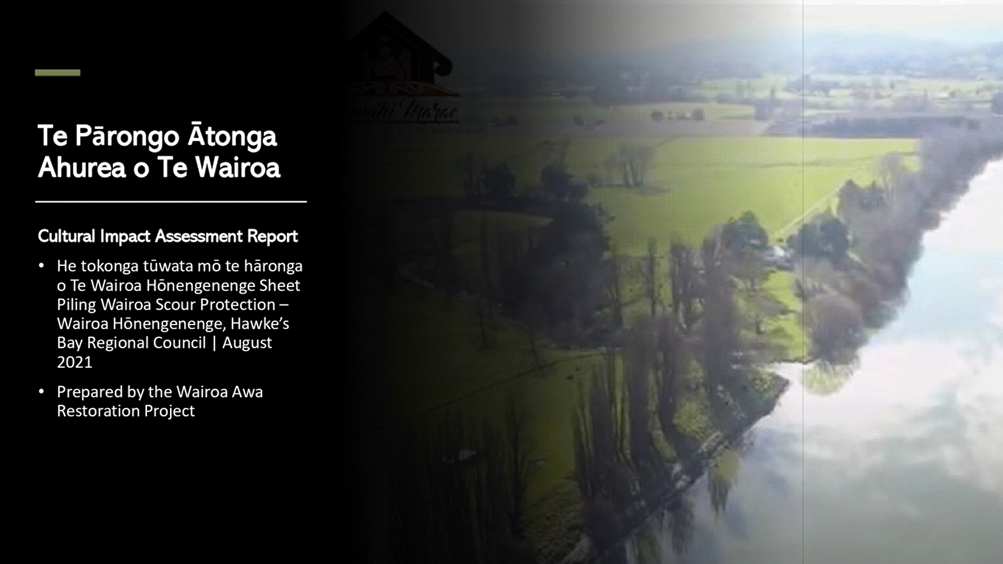
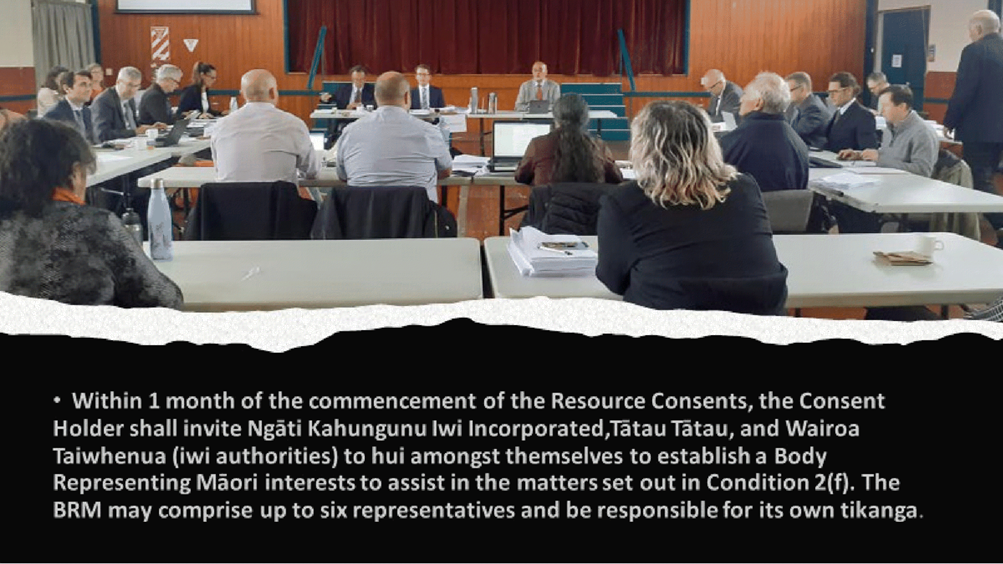

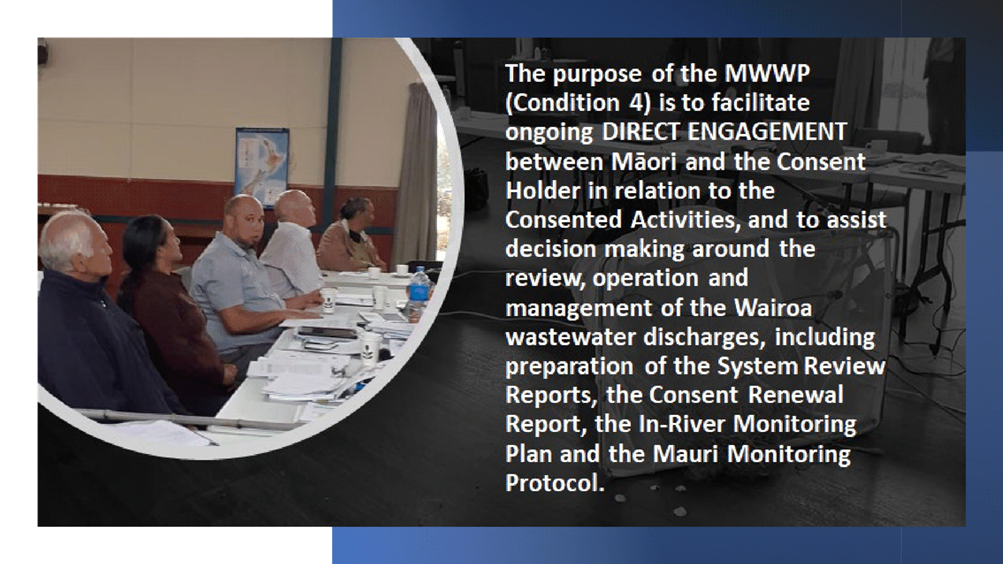
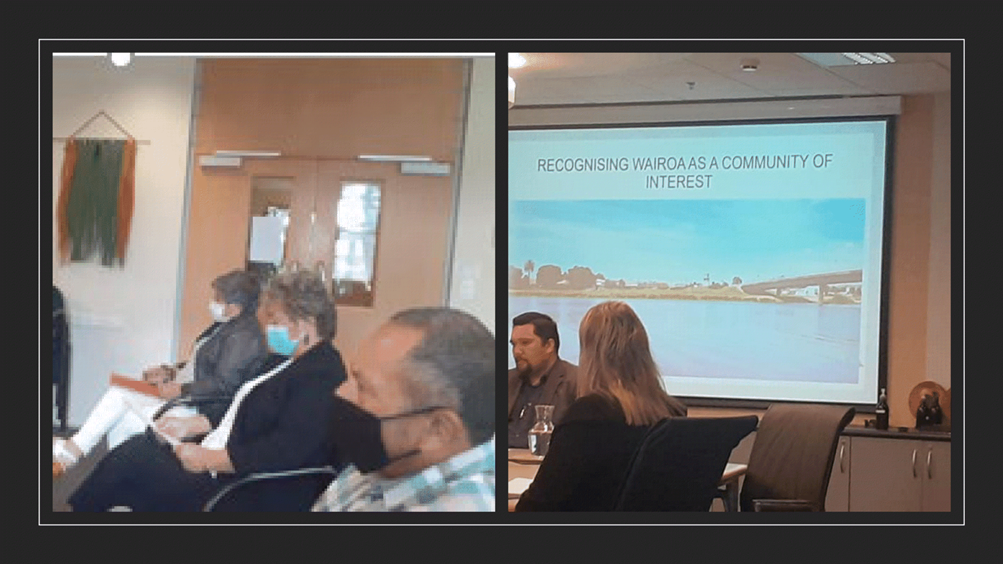
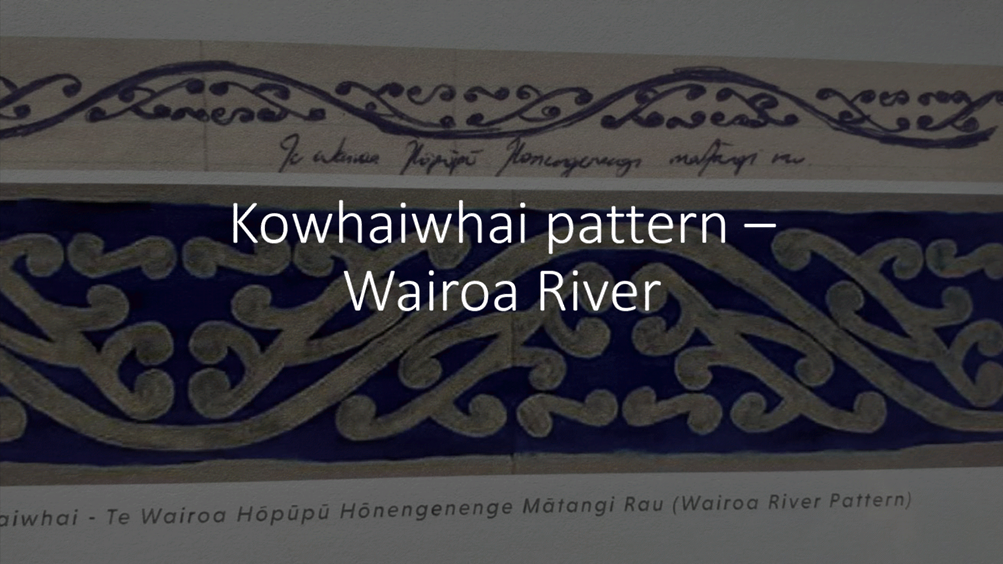
HAWKE’S
BAY REGIONAL COUNCIL
Māori
Committee
Wednesday 03 November 2021
Subject: Follow-ups from
Previous Māori Committee Meetings
Reason for Report
1. Attachment 1 lists items
raised at previous meetings that require follow-up, who is responsible, when it
is expected to be completed and a brief status comment. Once the items have
been reported to the Committee they will be removed from the list.
Decision Making Process
2. Staff
have assessed the requirements of the Local Government Act 2002 in relation to
this item and have concluded that, as this report is for information only, the
decision making provisions do not apply.
Recommendation
That the Māori Committee receives and notes the
“Follow-up Items from Previous Meetings” staff report.
Authored by:
|
Annelie Roets
Governance Advisor
|
|
Approved by:
|
James Palmer
Chief Executive
|
|
Attachment/s
|
1⇩
|
Follow-ups
for November 2021 Maori Committee
|
|
|
|
Follow-ups
for November 2021 Maori Committee
|
Attachment 1
|
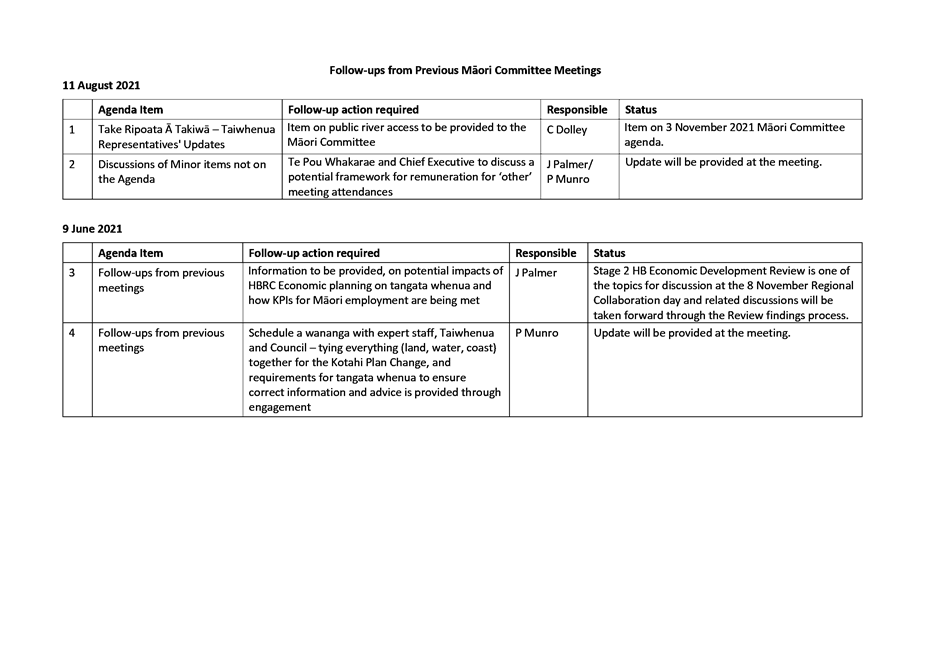
HAWKE’S BAY REGIONAL COUNCIL
Māori
Committee
Wednesday 03 November 2021
Subject: Call for Minor Items
Not on the Agenda
Reason for Report
1. This item
provides the means for committee members to raise minor matters they wish to
bring to the attention of the meeting.
2. Hawke’s
Bay Regional Council standing order 9.13 states:
2.1 “A meeting may discuss an item that is not on the agenda only if it
is a minor matter relating to the general business of the meeting and the
Chairperson explains at the beginning of the public part of the meeting that
the item will be discussed. However, the meeting may not make a resolution,
decision, or recommendation about the item, except to refer it to a subsequent
meeting for further discussion.”
Recommendation
That the Māori
Committee accepts the following
“Minor Items Not on the Agenda” for discussion as Item17:
Authored by:
|
Annelie Roets
Governance Advisor
|
|
Approved by:
|
James Palmer
Chief Executive
|
|
Attachment/s
There are no
attachments for this report.
HAWKE’S
BAY REGIONAL COUNCIL
Māori
Committee
Wednesday 03 November 2021
Subject: Public Use of Rivers
Reason for Report
1. This item
updates the Māori Committee on the investigations into the Management of
Public Use of River Berms (PUR) and updates on the consultation process with
the different iwi groups to engage with the Tāngata Whenua with open
communication and build a positive relationship.
Executive Summary
2. In 2016 HBRC
undertook a review of how its key river corridors are managed and how our
management obligations and their use by the public can be best accommodated.
This was in response to increased expectations by the community in regard to
the provision of space for recreational activities and the effects associated
with those activities. In particular, how Council balances such effects with
their other management responsibilities such as flood protection and
biodiversity outcomes.
3. The primary
goal of this project was to explore various management and maintenance methods
for the river corridors and a review of existing and potential public use
activities. The report would then provide provision of guidance on the most
appropriate management methods and outline a long term plan for management.
4. The PUR project
has been put on hold after the adoption of the report in 2019 due to:
4.1. Insufficient
detail of the HPFCS LoS project in identifying the improvements required to
deliver a resilient scheme to a 1:500 year of projection. This is to ensure
that the primacy of the scheme is maintained and informs the PUR work. This
will assist in minimizing an inefficient use of capital.
4.2. It has been
identified that no comprehensive iwi engagement had been undertaken and a
consultation has only taken place with existing recreation groups.
Effective iwi consultation was required to inform the PUR project in terms of
sites of importance, iwi culture and aspirations.
5. It is noted
that some consultations have already commenced as part of the ongoing planting
and flood protection work with different iwi groups and other river users (4W
drivers club, motocross club, BMX users).
6. As part of this
work we are identifying known culturally sensitive sites. The project team has
mapped all known sensitive cultural sites and engaged an archaeologist to work
with us through the project planning.
7. In summary, we
will engage with Tāngata Whenua to understand their values and aspirations
for the HPFCS. We like to start engaging and requesting to attend hui at each
hapū on the Heretaunga Plains individually. Initially, this means
potentially 18 separate hui- however, this may change as we progress further.
8. We propose to
start these conversations as value-based engagement instead of focusing on the
objective of the project. We also incorporate Hapū Management Plans as the
start of the engagement process.
9. The project
area is considered for both LoS (IRG) (priority areas) and Public Use of
Rivers as a whole of the HPFCS. As previously stated, we intend to focus
on building a positive relationship with hapū, understanding their values,
and we know that this will take time. We are proposing to have ongoing
consultation for beyond the IRG project.
10. The project LoS (IRG) and
Public Use of Rivers is restricted to the land owned and managed by the Council
as part of the flood control scheme. It does not cover any privately owned
land.
11. High-level planning for
some of the river access points as part of the Level of Service upgrade work is
underway with some consultation with the iwi group already in place.
Background
12. HBRC’s Asset
Management Group is responsible for managing the flood protection schemes
including access points and public spaces within the scheme areas. There are
existing issues of vandalism, antisocial behaviour, rubbish dumping,
undesirable vehicle use, freedom camping and illegal or antisocial activities
have been ongoing for too long and appear to be escalating. These issues often
involve health and safety matters as well as environmental damage, at an
increasing cost to ratepayers.
13. In December 2016, a paper
and report “Review of Use of Heretaunga Plains Scheme River Berm
Land” was presented to the Environment and Services Committee advising of
an investigation into Management of Public Use of River Berms within the
Heretaunga Plains Flood Control Scheme followed by an update to the 13
September 2017 meeting on investigations to understand and / or respond to:
13.1. Perceived declining regional
community tolerance over some aspects of river berm management, such as berm
grazing.
13.2. Increasing community
level of service expectations as berm land has become both more accessible
through higher public use such as cycle trails and more visible due to
expressway developments.
13.3. Pressures on scheme land
area to accommodate new activities and infrastructure such as horse trails,
jet-ski/ boat ramps, carparks and sports grounds whilst not compromising flood
protection services and the continued opportunity for existing public use and
activity.
13.4. Inappropriate public use
and activity such as rubbish dumping, vehicle hooning, freedom camping and
illegal activity.
13.5. The need to consider the
above in the context of multiple use opportunities such as flood control and
drainage objectives, iwi aspirations, biodiversity and ecological enhancements.
14. There are various Māori
accounts regarding naming, settlement and use of the awa. This stage of the
project is to engage with Iwi to enrich understanding of the cultural values
and find ways in which to celebrate and share appropriate cultural histories.
Discussion
15. The next step of this
project seeks to achieve the following key outcomes:
15.1. Enhance the
understanding of cultural values and history
15.2. Engaged a coordinator to
start the process on engaging with mana whenua
15.3. Work with mana whenua to
understand their aspirations for this area
16. Focus not only on the
priority areas and integrate this project with Level of Services review (IRG)
but also incorporate wider scheme areas.
Options Assessment
17. An option to progress with
the iwi engagement is a crucial link to Level of Service Upgrade work and
ongoing management of the rivers.
18. The option to actively and
openly engage and incorporate Iwi into this project will enhance the future
relationship of Māori and allow them to integrate their values into the
water, land, flora, and fauna within the flood protection.
Significance and Engagement Policy Assessment
19. Under the Council’s
Significant and Engagement Policy this project is identify as a significant due
to the Heretaunga Plains Flood project Scheme is considered to be a strategic
assets.
20. The engagement
spectrum and level of engagement under the policy is 3. Collaborate,
working together.

Considerations of Tāngata Whenua
21. Considerations from
tāngata whenua enables them to have input and integrate their values into
the water, land, flora and fauna within the flood protection scheme.
22. Mana whenua will be able
to have significant sites mapped out, identified and formally acknowledged.
23. There will be the
opportunity to incorporate existing and future Hapū Management Plans into
this project.
24. There is an opportunity to
work on a creative project to incorporate, educate and celebrate the unique
cultural history of these areas.
Next Steps
25. To optimise the use of
capital, the Asset Management Group intends to integrate outcomes of the PUR
project into HPFCS LoS program. This will coordinate deliverables of both
programmes at key prioritised sites, identified as part of the IRG funded
projects.
26. Key outcomes are also to:
26.1. Enhance the understanding of cultural
values and history
26.2. Work with mana whenua and archaeologists
to map and protect significant sites
26.3. Incorporate aspects of existing Hapū
Management Plans into this project
26.4 Invite input from Iwi and hapū
into priorities managing the HPFCS that reflects the culture and aspirations of
Iwi
26.5 Develop opportunities for education
to celebrate appropriate cultural history.
27. The next steps are Iwi
engagement and public consultation.
28. Focused early consultation
for specific sites may be led through HPFCS LoS upgrade projects and later
incorporated into the greater PUR project.
Decision Making Process
29. Staff have assessed the
requirements of the Local Government Act 2002 in relation to this item and have
concluded that, as this report is for information only, the decision making
provisions do not apply.
Recommendation
That the Māori
Committee receives and notes the “Public Use of Rivers”
staff report.
Authored by:
|
Melanie
Taiaroa
Senior Advisor Māori Partnerships
|
Martina
Groves
Manager Regional Assets
|
Approved by:
|
Chris Dolley
Group Manager Asset Management
|
|
Attachment/s
There are no
attachments for this report.
HAWKE’S BAY REGIONAL COUNCIL
Māori
Committee
Wednesday 03 November 2021
Subject: Possom Control Area -
Partial Regional Pest Management Plan Review
Reason for Report
1. To provide
background to a review of Hawkes Bay Regional Councils Possum Control Area
(PCA) programme.
2. To update the Committee on the
partial plan review process for the Possum Control Area (PCA) programme and
to advise membership of the Bio-Working Party (BWP) that will hear the proposed
partial plan change.
Executive Summary
3. In August 2020
a S17a review of HBRC biosecurity programmes effectiveness and efficiency was
completed.
4. One of the key
recommendations of the Section 17a review was that a full review of the Possum
Control Area (PCA) programme be undertaken. That review of the PCA programme
has been completed, making the primary recommendation that Hawke’s Bay
Regional Council should move to a contractor-based model for possum control.
5. The 12 May 2021
Environment and Integrated Catchments Committee (EICC) directed council staff
undertake the first step of drafting a proposal that includes a discussion of
the costs and benefits of different delivery models for possum management in
Hawke’s Bay and the most appropriate funding model. This proposal will be
brought back to Council for subsequent consideration and decision making.
6. At the 8
September 2021 EICC it was discussed that in
undertaking the public notification and receipt of submissions process, as part
of the consultation plan, a hearing panel is required to hear submissions. This
panel (the BWP) can also be delegated the authority to make certain decisions
under the Act.
Background/Discussion
7. One of the key
recommendations of the Section 17a review completed in August 2020 was that a
full review of the Possum Control Area (PCA) programme be undertaken. That
review of the PCA programme has been completed, making the primary
recommendation that Hawke’s Bay Regional Council should move to a
contractor-based model for possum control.
8. The PCA Review
report also made the secondary recommendation that a funding options analysis
should be undertaken to assess the beneficiaries and exacerbators of the
programme to determine the most appropriate funding model. These considerations
will affect how the financial impact of any new approach to possum control
would be spread across the community.
9. The PCA Review
report also made several other operational recommendations around pest plant
management.
10. If council was to move to a contractor-based model for possum
management across approximately 800,000 ha covering both rural and urban areas,
an increase in operational budget will be required. Alongside this, the PCA
programme will continue to grow as areas roll out of OSPRI vector management
and enter the PCA programme.
11. Although a detailed
analysis of a contractor-based model has not yet been completed, an estimated
cost for landscape maintenance control from Hawke’s Bay possum
contractors contacted as part of the PCA review was $7-8/ha. Please note this
cost would only apply to the area controlled within the PCA area boundary in
any one year.
12. If a substantive change is
made to the current delivery model for possum management in Hawke’s Bay,
a partial plan review to amend the current Regional Pest Management Plan (RPMP)
will be required. The steps to making a RPMP are clearly outlined within
sections 70 to 77 of the Biosecurity Act 1993. The first step is for Council to
make a proposal in accordance with section 70 of the Biosecurity Act 1993 that
demonstrates how numerous provisions have been met.
13. The cost benefit analysis
(CBA) is in the process of being updated by Lincoln University from the work
undertaken in 2017-18 for the Regional Pest Management Plan. The CBA will
indicate whether the net benefit exceeds the cost of implementing a HBRC
managed contractor model.
14. In considering options to
change the current PCA programme to HBRC managed contracting there are key
elements that impact on programme cost, risk and outcomes delivered. These
include the:
14.1. Speed of implementation
- Depending on the amount of OSPRI TBFree work in the region there will be
between 700-800,000 ha of land to transition to HBRC managed contracts. Noting
that not all this land area will need to be actively managed all of the time, implementation
of large-scale contracting over this area could take place anywhere between 3-5
years with the timeframe determining the rating increases required.
14.2. Contract targets and
structure – will be important in determining contract risk for contractors
and HBRC, the outcomes that are likely, longer term contractor market capacity
and contract / management cost.
14.3. Outcomes council seeks
from its investment – different levels of possum control are likely to
deliver different outcome results.
15. Other regional councils
also have large scale targeted possum control programmes. Staff have met with
Environment Waikato, Horizons and Greater Wellington biosecurity teams to
better understand their programmes. While there are a number of differences between
programmes there are some common themes. These include:
15.1. Challenges around
reducing contractor capacity where large-scale contracts are applied in the
region
15.2. The importance of
resourcing the management of contracting programmes at an appropriate level
particularly contract management, auditing and data management
15.3. The importance of having
some way to measure the contribution of programmes to biodiversity outcomes.
16. At the 8 September EICC it
was discussed that in undertaking the public
notification and receipt of submissions process, as part of the consultation
plan, a hearing panel is required to hear submissions. This panel (the BWP) can
also be delegated the authority to make certain decisions under the Act.
17. The
decisions that a hearings panel can be required to make with delegated
authority are:
17.1. Considering
and recommending advice on the PCA partial plan review process and key issues
17.2. Considering
reports on the PCA partial plan review and giving guidance on recommended
approach
17.3. Considering
reports on the PCA partial plan review proposal and reviewing and giving
guidance on the proposal and providing guidance on the alignment of the partial
plan review with other plans and strategies
17.4. Reviewing
and giving guidance on received submissions.
18. During
the 2019 - 2039 RPMP development, the BWP included one independent, out of
region member, with both biosecurity and hearings process experience, to sit on
the panel as a biosecurity expert. This worked well and staff recommend this
take place for the partial plan review as well.
19. At
the 10 November EICC it will be proposed that:
19.1. the
chair of the BWP panel (determined by panel members) will be delegated powers
to have a casting vote in the event that the committee is unable to reach a
majority on any matter
19.2. councillors Will Foley, Jerf Van Beek, Craig Foss,
Charles Lambert and Jacqueline Taylor are formally adopted as members of the
BWP.
20. Two members of the Hearing
Panel delegated from the Māori Committee have also agreed to be formally
appointed as part of the BWP. Both Roger Maaka and Katarina Kawana have
appropriate hearings expertise and bring a tangata whenua perspective
Option
Assessment
21. There are three options
for the management of the PCA programme that will be explored over the next
eight months. These include:
21.1. Large scale targeted
HBRC managed possum control contracts
21.2. Increasing the
resourcing of the current PCA programme so that it is able to deliver its
Levels of Service long term
22. Ceasing the current PCA
programme.
Strategic Fit
23. The PCA programme sits
within the RPMP. The RPMP plays an important role in achieving both the
Biodiversity and Land strategic outcomes and goals in the HBRC Strategic Pan
2020-25.
24. Pest management sits
within a biosecurity framework for the Hawke’s Bay region, which includes
the RPMP, the Hawke’s Bay Biodiversity Strategy and the HBRC Strategic
Plan. Neighbouring Regional Pest Management Plans and national legislation, policy
and initiatives have also influenced this Plan.
25. All programmes sitting
within an RPMP are required to have clear measurable outcomes, which are
specified within the monitoring section. This monitoring section is integrated
into the Biosecurity Annual Operational Plan, which goes to council for
approval prior to each financial year. The Operational Plan sets out the
operational delivery for each programme and the monitoring and reporting
requirements. Staff report to council annually (November) on the progress of
the Operational Plan.
26. Failing to achieve the
RPMP objective and council Level of Service Measures for the PCA programme
could affect achieving the strategic outcomes and goals in the HBRC Strategic
Pan 2020-25 for Biodiversity and Land.
Financial and Resource Implications
27. Both
the large scale contracting and increased resources to the current PCA
programme will have potentially significant resource implications that will
require annual or Long-Term plan public consultation.
Decision Making Process
28. Staff have assessed the
requirements of the Local Government Act 2002 in relation to this item and have
concluded that, as this report is for information only, the decision making
provisions do not apply.…
Recommendation
1. That the
Māori Committee receives the “Possum Control Area - Partial Regional
Pest Management Plan Review” staff report.
Authored by:
|
Campbell
Leckie
Manager Catchment Services
|
|
Approved by:
|
Iain Maxwell
Group Manager Integrated Catchment
Management
|
|
Attachment/s
There are no
attachments for this report.
HAWKE’S BAY REGIONAL COUNCIL
Māori
Committee
Wednesday 03 November 2021
Subject: Coastal Bird Survey
Results
Reason for Report
1. This report
provides a summary of the results of a baseline survey of indigenous bird
values along the Hawke’s Bay coastline (the survey). An introduction to
this survey was brought to the committee in November 2020, and the completed
report has been published (HBRC 5560) and is available on our website.
Executive Summary
2. Hawke’s
Bay supports a vast array of coastal bird species along our diverse coastline.
As part of our responsibilities for the sustainable management of natural
resources, and in line with our strategic goal of healthy, functioning and
climate-resilient biodiversity, a baseline survey of these bird species using
areas of our coast and estuaries was required to provide HBRC with population
estimates and detailed distribution maps for Hawke’s Bay’s coastal
bird species.
3. A total of 321
km of the Hawke’s Bay coastline (from south of Whangaehu beach to
Mahanga) was traversed either by foot or by boat, and the presence and number
of all species of birds and marine mammals encountered was recorded for each
separate 1 km section of coastline surveyed.
4. A total of 79
bird species and two marine mammal species were detected during this survey. 57
bird species (72%) are native or endemic to New Zealand, and 28 of these
species (35%) are ranked as either Nationally Threatened or At Risk under the
New Zealand Threat Classification System.
5. Local
indigenous species diversity was highest at estuaries, river mouths and coastal
lagoons, on inshore islands and along sections of coastline with mixed rocky
shore and sandy beach habitats.
6. Maungawhio
Lagoon and the eastern coast of Māhia Peninsula, Te
Whanganui-a-Orotū/Ahuriri Estuary and the Pōrangahau Estuary are
nationally and regionally important habitats for a range of Arctic-breeding and
endemic shorebird species, including kuaka/bar-tailed godwit, ruddy turnstone,
pohowera/banded dotterel and ngutu pare/wrybill.
7. Based on the
findings of the survey, changes to the regional threat rankings of 12 of the 23
bird species are recommended; four species have an improved status, six species
have a worsening status, and two species have a neutral status. Nine of these
changes are a result from new data collected during this survey.
Strategic Fit
8. The survey
contributes to our strategic goal of healthy, functioning and climate-resilient
biodiversity (HBRC Strategic Plan 2017-2021).
9. It includes
critical information to increase the effectiveness to implement existing and
upcoming statutory frameworks including:
9.1. Regional
Coastal Environment Plan
9.2. New Zealand
Marine Oil Spill Readiness and Response Strategy 2018-2022
9.3. National
Policy Statement for Indigenous Biodiversity.
10. This work also contributes to Kotahi
policy development for determining Significant Conservation Areas.
11. The survey aligns with
programmes in Biosecurity, Biodiversity, Predator Free Hawke’s Bay,
Coastal/Marine Science, and Policy work streams. The dataset will inform
the Ecosystem Prioritisation Programme, Coastal and Marine ecosystem
prioritisation (in progress), and Outstanding Water Bodies.
Background
12. The
Hawke’s Bay coastline (ca 345 km) is an important breeding and foraging
ground for many indigenous birds. Many of these species are at risk of
extinction due to habitat loss and degradation, predation, and impacts from
other human activities. Climate change is likely to add compounded
challenges to these species.
13. Hawke’s Bay Regional
Council (HBRC) has statutory responsibilities relating to the sustainable
management of the natural values of the Hawke’s Bay coastline, including
its indigenous bird values.
14. HBRC commissioned a
complete and systematic survey of the indigenous bird values of the
Hawke’s Bay coastline in January 2021, to create a regional-scale
baseline measure of the diversity, distribution and abundance of indigenous
birds inhabiting the Hawke’s Bay coastline.
Discussion
15. The survey:
15.1. Covered 321 km of the
region’s approximately 345km coastline by foot or boat
15.1.1. 24 km of the coast was not surveyed
(north of Kairakau to Waimarama and the eastern side of Mahia Peninsula) due to
lack of landowner approval or inaccessibility
15.2. Recorded 79 bird species
and two marine mammal species (NZ fur seals and common dolphins)
15.3. Recorded 32,660 individual
birds.
16. 28 of the bird species
detected (35%) are ranked as either Nationally Threatened or At Risk under the
New Zealand Threat Classification System, including:
16.1. 4 species ranked as
Nationally Critical
16.2. 1 species ranked as
Nationally Endangered
16.3. 4 species ranked as
Nationally Vulnerable
16.4. 8 species ranked as At
Risk, Declining
16.5. 2 species ranked as At
Risk, Relict
16.6. 4 species ranked as At
Risk, Recovering and
16.7. 5 species ranked as At
Risk, Naturally Uncommon.
17. 19 of the bird species
detected (24%) are ranked as Regionally Threatened under the New Zealand Threat
Classification System, including:
17.1. 12 species ranked as
Regionally Critical
17.2. 3 species ranked as
Regionally Endangered and
17.3. 4 species ranked as
Regionally Vulnerable.
18. The survey highlighted the
role that larger estuaries and river mouths play as areas of high species
richness. Stretches of the mainland coastline that possessed a heterogeneous
mix of habitats including a mix of sandy or shingle beaches and intertidal rock
platforms also supported a higher diversity of indigenous bird species,
including the eastern coastline of Māhia Peninsula, the coastline between
Tangoio and the Moeangiangi River, and the coastline between Pōrangahau
and Pourerere beaches.
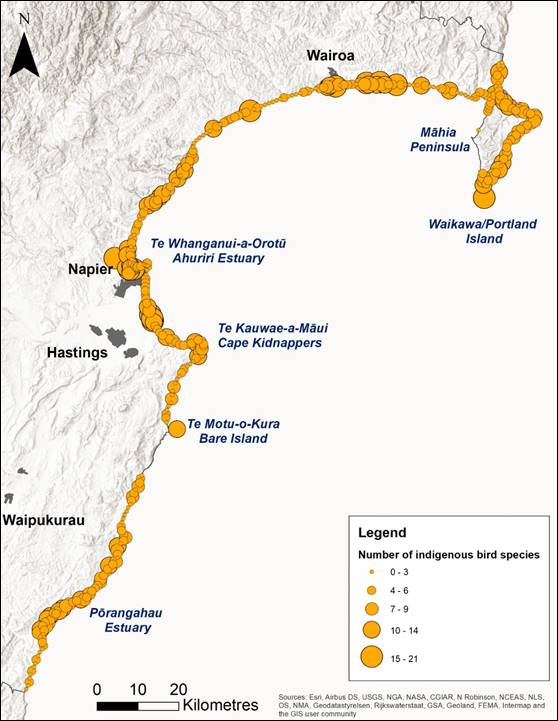
19. Among the 65 estuaries and
coastal lagoons surveyed, Te Whanganui-a-Orotū/Ahuriri Estuary supported
the highest diversity of indigenous birds with 33 species and 3,356 individuals
counted. The Pōrangahau Estuary supported the second highest number of
indigenous bird species, with 24 species and 1,311 individuals counted, and the
Maungawhio Lagoon supported the third highest number of species, with 22
species and 420 individual birds counted.
20. Key findings of the survey
include that:
20.1. Hawke’s Bay
supports 16% of the global population of pohowera / banded dotterel
20.2. Tūturiwhatu / New
Zealand dotterels have experienced a substantial increase in population size
and breeding range along the Hawke’s Bay coastline since 2011 due to a
successful species recovery plan
20.3. Hākoakoa / sooty
shearwaters were re-discovered to be breeding on Te Motu-o-Kura Island.
Next Steps
21. Changes to the regional
threat rankings of 12 of the 23 bird species are being recommended to HBRC; four
species have an improved status, six species have a worsening status, and two
species have a neutral status. Nine of these changes are a result from new data
collected during this survey.
22. Three interactive workshop
days are being organised as part of the programme for the community, where
people can not only learn about the birds and survey method, but also exchange
their knowledge of birds and habitats from their points of view. These
workshops will be in early December:
22.1. 2 Dec (Thursday) –
Wairoa 5:30-7pm
22.2. 3 Dec (Friday) –
Waitangi Regional Park
22.3. 5 Dec (Sunday) –
Aramoana.
Decision Making Process
23. Staff have assessed the
requirements of the Local Government Act 2002 in relation to this item and have
concluded that, as this report is for information only, the decision-making
provisions do not apply.
Recommendation
That the
Māori Committee receives and notes the “Coastal Bird Survey
Results” staff report.
Authored by:
|
Becky
Shanahan
Scientist Marine and Coasts
|
Anna Madarasz-Smith
Team Leader/Principal Scientist Marine &
Coast
|
Approved by:
|
Iain Maxwell
Group Manager Integrated Catchment
Management
|
|
Attachment/s
There are no
attachments for this report.
HAWKE’S BAY REGIONAL COUNCIL
Māori
Committee
Wednesday 03 November 2021
Subject: LiDAR Partnership
Programme Follow-up
Reason for Report
1. This report
follows on from the 10 June presentation introducing the LiDAR programme and
seeks feedback about if, and how, the Māori Committee wishes to be
involved with the programme in future.
Background
2. Hawke’s
Bay Regional Council has recently acquired LiDAR mapping for the whole of the
Hawke’s Bay region (due to be delivered by the end of the year). This
will enable us to have an unprecedented view of the region, allowing us for the
first time to strip surface vegetation from imaging and view the shape of the
land and infrastructure in extremely high definition.
3. A partnership
has been established with Manaaki Whenua Landcare Research (MWLR). An initial
scoping exercise was conducted within Council and the following projects were
chosen.
3.1. Improving
understanding and management of erosion with LiDAR, including:
3.1.1. Upgraded regional erosion and
sediment load modelling
3.1.2. Upgraded regional-scale
landslide modelling
3.1.3. Improvement to the mapping of
the stream network.
3.2. Improving
land characterisation with LiDAR, including:
3.2.1. Improvements to soils mapping
3.2.2. Farm scale slope mapping
3.2.3. Identifying Critical Source
Areas and assessing flow paths
3.2.4. Estimating surface roughness
3.2.5. Mapping field drains.
3.3. Producing a
vegetation layer that could be used for identifying and mapping different types
of vegetation (e.g., riparian, wetland, shelterbelt, forest fragments, single
trees).
3.4. Improving
cultural mapping with LiDAR. This covers the identification of likely
Pā-sites, middens, wahi tapu sites. The DEM would be used to support
discussions with hapū and likely or potential sites identified.
3.5. Seed funding
to determine the potential of LiDAR or building an analytical process to try
and derive Ecosystem services information e.g. carbon stocks, recreational
value from LiDAR point cloud information etc.
3.6. Extension and
testing. This aims to make information from whole LiDAR partnership programme
available and accessible for hapū and Māori landowners, farmers,
community groups and general public and testing outputs to see if they support
land use decision making.
4. A small team
from HBRC and Manaaki Whenua will come together regularly to oversee the
programme.
5. The project
also has an HBRC reference group of Dr Barry Lynch (Team Leader Land Science),
Craig Goodier (Team leader Engineering), Andrew Burton (Senior Catchment
Advisor) and Tim Farrier (GIS/LiDAR Analyst), and project sponsors: Pieri Munro
and Iain Maxwell. All of whom were involved in the scoping of the programme.
6. Melissa
Robson-Williams from Manaaki Whenua is working with Dr Barry Lynch of HBRC to
ensure that the programme of work is well connected with HBRC through the
engagement and testing workstream.
7. As part of the
development of these tools we would like to know if and how you would like to
be involved with the overall programme or any of the individual projects.
Next Steps
8. We expect the
LiDAR to be ready for use by the end of the year, and for work to commence in
early 2022.
Decision Making Process
9. Staff have
assessed the requirements of the Local Government Act 2002 in relation to this
item and have concluded that, as this report is for information only, the
decision making provisions do not apply.
Recommendation
That the Māori
Committee receives and notes the “LiDAR Partnership Programme
Follow-up” staff report and presentation and proposes views or ideas
on future involvement with the programme.
Authored by:
|
Dr Barry
Lynch
Team Leader/Principal Scientist (Land
Science)
|
Dr Melissa
Robson Williams
ENVIRONMENTAL SCIENTIST,
TRANSDISCIPLINARY RESEARCHER
MANAAKI WHENUA – LANDCARE
RESEARCH
|
Approved by:
|
Iain Maxwell
Group Manager Integrated Catchment
Management
|
|
Attachment/s
There are no
attachments for this report.
HAWKE’S BAY REGIONAL
COUNCIL
Māori
Committee
Wednesday 03 November 2021
Subject: Reports from Regional
Council and Committee Meetings
Reason for Report
1. This item provides information from recent meetings attended by
Māori Committee representatives, and the opportunity for the Committee to
discuss any matters of particular interest arising from those meetings.
Environment and Integrated Catchments
Committee (EICC)
2. Dr Roger Maaka represents the Māori Committee on the EICC, which met on 8 September 2021 and
considered the following agenda items.
3. The Biosecurity
2020-21 Annual Report and 2021-22 Operational Plan item presented
the Hawke’s Bay Regional Council’s Biosecurity Annual Report for
the 2020-21 year and the Operational Plan for the 2021-2022 year for adoption,
noting that almost all programme objectives were achieved.
4. The Right
Tree Right Place Project Acceleration item sought and was granted
Council’s agreement to bring forward up to $500,000 in operating
expenditure from year-3 (2023-24) to year-1
(2021 22) for accelerated activity in farmer engagement and the
completion of detailed farm plans on a representative number of properties.
5. The Enviroschools
2020-21 Update item highlighted how the school programmes expose learners
to Council activities such as work in Open spaces, biodiversity and catchment
teams. It was agreed that an invitation will be extended to the Youth
Council to attend the November EICC meeting.
6. The Possum
Control Area Partial Plan Review Update item covered the preparation of the
proposal for a partial plan review for the Possum Control Area (PCA) programme
to shift to a contractor based framework.
7. An
Introduction to the Catchments Policy Implementation Work Programme covered
what activities the team is responsible for including:
7.1. ensuring the
necessary resources and processes are in place to effectively implement the rules
and policies in Council’s RMA plans
7.2. working
collaboratively with National and regional sector working groups on
implementation of National regulations
8. The Update
on the 3D Aquifer Mapping Project (SKYTEM) item presented progress on the 3D Aquifer mapping
project, including an overview of the data collected, the analysis undertaken
and some of the preliminary findings.
9. The Update
on the Whakaheke o Te Wai (TWOTW): MBIE Funded Endeavour Programme and
Heretaunga Plains Groundwater Case Studies item provided an overview on the progress of this programme, including:
9.1. Five
different groundwater models at different scales are being developed within the
Heretaunga Plains (4 physically based groundwater models and 1 statistical
(hybrid) model which supports the National ground water model
9.2. An archive of
mātauranga Māori on the Heretaunga Plains is being compiled, focusses
on identifying the long-term changes in the groundwater-surface water system
– Ngāti Kahungunu and Heretaunga Taiwhenua are collaboratively
involved in this project.
10. The Update on IRG Flood
Control Resilience Funded Projects item provided an update on the four
projects approved for funding as part of the Crown’s Flood Control
Resilience Funding with the Infrastructure Reference Group managed by
Kānoa (previously Provincial Development Unit), including:
10.1. Heretaunga
Plains Flood Control Scheme (HPFCS) Levels of Service
10.2. Upper
Tukituki Gravel Extraction Flood Control Scheme
10.3. Upper
Tukituki Flood Control Scheme SH50/Waipawa Erosion
10.4. Wairoa River, River
Parade Erosion
10.5. More information can be
found as part of the Significant Activities report in this Agenda.
11. The Public Use of
Rivers (PUR) item updated the Committee on investigations into the Public
Use of River Berms within the Heretaunga Flood Control Scheme, including issues
with rubbish dumping and vandalism, freedom camping, illegal or antisocial
behaviour which causes significant health and environmental damage.
Regional Transport Committee (RTC)
12. Api Robin
represents the Māori
Committee on the Regional Transport Committee, which met on 17 September 2021
and considered the following agenda items.
13. The Roadsafe Annual
Plan item provided the Committee with an overview of the main
activities carried out by Roadsafe Hawke’s Bay over the past year, and
the programme for the coming financial year. Highlights included the successful
delivery of the HB Youth Roadsafe Expo, regular roadside support provided to
police and emergency services featuring road safety messages (including fatigue
and speed), the six new driving instructors trained across the region (still
looking for instructors in Wairoa) and the adoption of the Roadsafe Work Plan
for 2021-22 and agreed to reporting and performance measures.
14. The Roadsafe s17a
Review Outcomes item provided the Committee with background on Roadsafe HB
activities and sought agreement to undertake a section 17a review of the
programme.
15. The Public Transport
Update item provided the Committee with an update on bus patronage,
highlighting that passenger numbers are well down, a project team has been
assembled and the contracting process is underway for the On Demand Public
Transport trial, and the review of the Total Mobility scheme.
16. The Transport
Manager’s Update covered the appointment of Katie Nimon to the role
of Transport Manager, advice that the Ministry for the Environment (MfE) will
soon be consulting on NZ’s first Emissions Reduction Plan and issues with
the Wairoa to Gisborne rail link not being included in the National Land
Transport Plan.
17. The Waka Kotahi (NZTA)
Central Region – Regional Relationships Director’s Report provided
an update on NZTA projects and activities including the recent approval of
the National Land Transport Programme (total budget over 3 years $24.3B
including $376M for Hawke’s Bay) and expectation that the SH5 speed limit
review will be available to councils and Ministers in November 2021.
18. The Verbal Updates by
Advisory Representatives item covered:
18.1. Whakatu Inland Freight
Hub project is on hold
18.2. Napier Port is working
with the logging industry to address logging truck congestion in and around the
Port
18.3. KiwiRail will be
expanding its Wairoa - Napier service from a weekend only service to a daily
Monday through Friday service.
Regional Council
19. Co-chairs
Michelle McIlroy and Mike Paku are invited to attend Regional Council meetings
and workshops with full speaking rights (no voting rights). Since the Māori Committee last met on 11 August
2021, there have been three Regional Council meetings and one Extraordinary
Regional Council meeting on 13 October 2021. The Co-chairs will provide verbal
updates on discussions from those hui.
Decision Making
Process
20. Staff
have assessed the requirements of the Local Government Act 2002 in relation to
this item and have concluded that, as this report is for information only, the
decision-making provisions do not apply.
Recommendation
That the Māori Committee receives and notes the “Reports from Regional
Council and Committee Meetings”.
Authored by:
|
Annelie Roets
Governance Advisor
|
|
Approved by:
|
Leeanne
Hooper
Team Leader Governance
|
|
Attachment/s
There are no
attachments for this report.
HAWKE’S BAY REGIONAL COUNCIL
Māori
Committee
Wednesday 03 November 2021
Subject: October 2021 Statutory
Advocacy Update
Reason for Report
1. This item reports on proposals forwarded to the Regional Council and
assessed by staff acting under delegated authority as part of the
Council’s Statutory Advocacy project.
2. The Statutory Advocacy project (Project 196) centres on local
resource management-related proposals upon which the Regional Council has an
opportunity to make comments or to lodge a submission. These include, but
are not limited to:
2.1. resource consent applications publicly notified by a territorial
authority
2.2. district plan reviews or district plan changes released by a
territorial authority
2.3. private plan change requests publicly notified by a territorial
authority
2.4. notices of requirements for designations in district plans
2.5. non-statutory strategies, structure plans, registrations, etc
prepared by territorial authorities, government ministries or other agencies
involved in resource management.
3. In all cases, the Regional Council is not the
decision-maker, applicant nor proponent. In the Statutory Advocacy project, the
Regional Council is purely an agency with an opportunity to make comments or
lodge submissions on others’ proposals. The Council’s position in
relation to such proposals is informed by the Council’s own Plans,
Policies and Strategies, plus its land ownership or asset management interests.
4. The summary outlines those proposals that the Council’s
Statutory Advocacy project is currently actively engaged in.
Decision Making
Process
5. Staff have
assessed the requirements of the Local Government Act 2002 in relation to this
item and have concluded that, as this report is for information only, the
decision-making provisions do not apply.
Recommendation
That the Māori
Committee receives and notes the “October 2021 Statutory
Advocacy” report.
Authored by:
|
Ellen
Robotham
Policy Planner
|
Nichola
Nicholson
Policy Planner
|
Approved by:
|
Ceri Edmonds
Manager Policy and Planning
|
|
Attachment/s
|
1⇩
|
October 2021
Statutory Advocacy Update
|
|
|
|
October
2021 Statutory Advocacy Update
|
Attachment 1
|
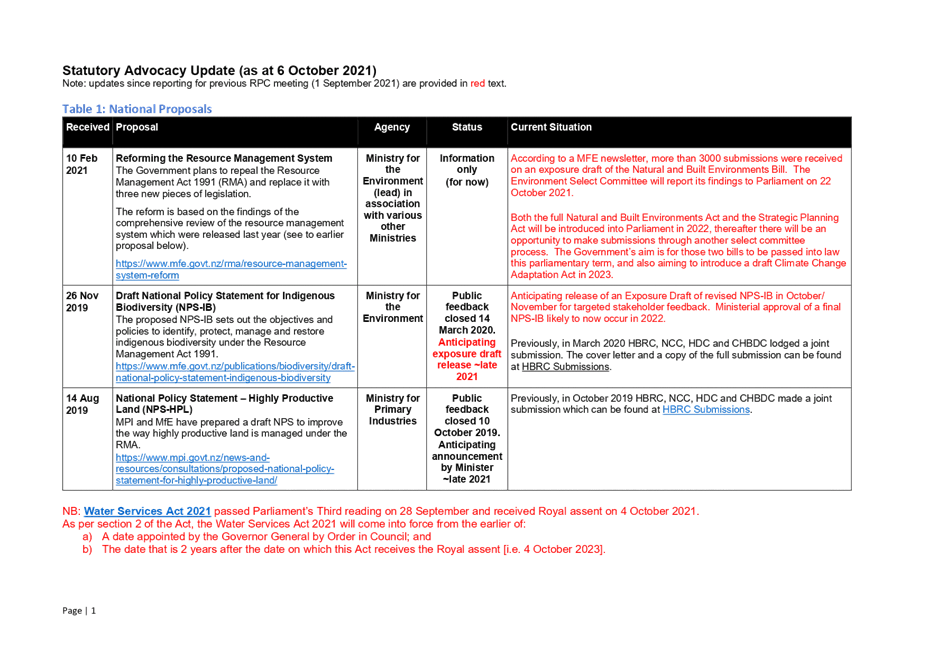
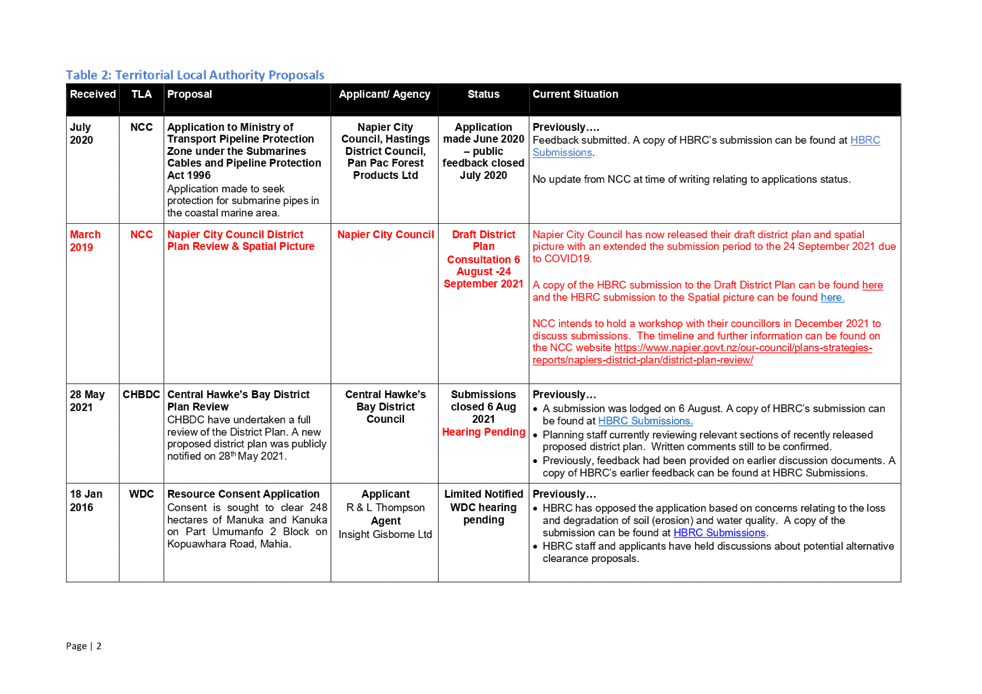
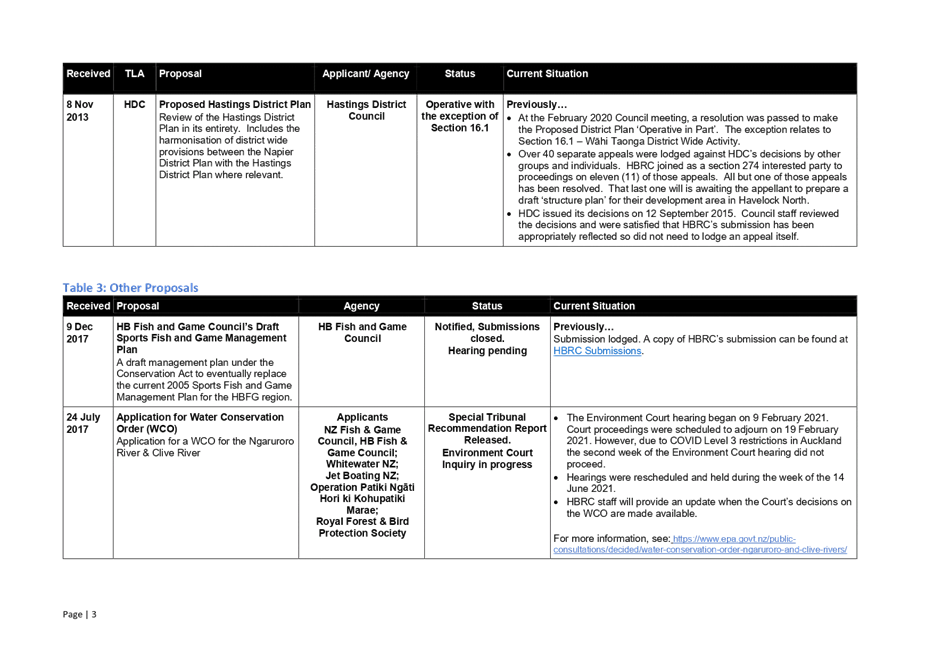
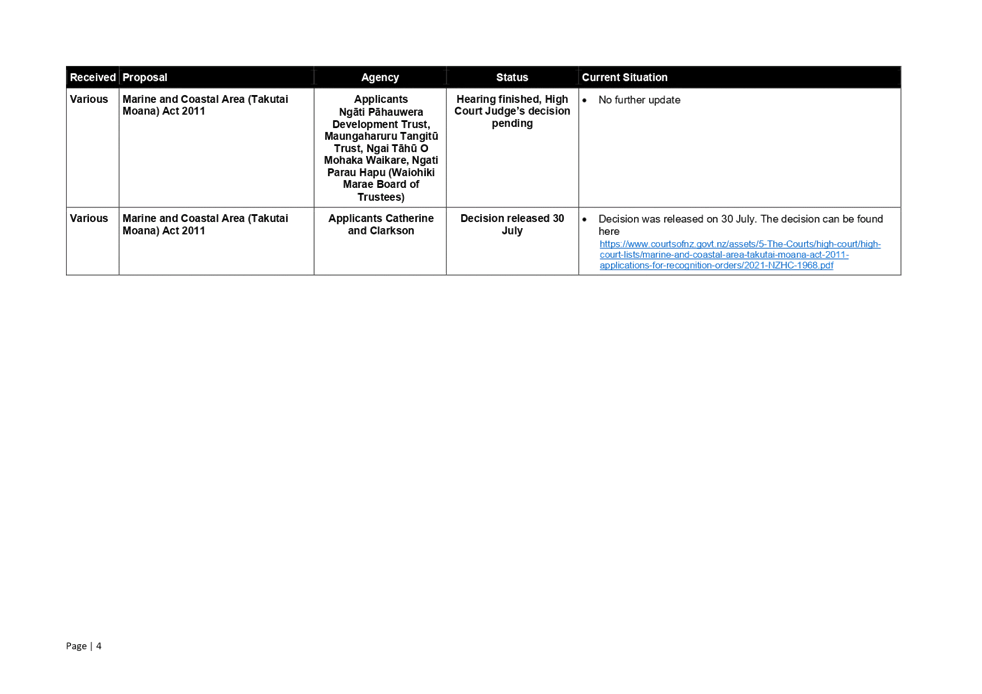
HAWKE’S
BAY REGIONAL COUNCIL
Māori
Committee
Wednesday 03 November 2021
Subject: Significant Organisational
Activities Looking Forward through November 2021
Reason for Report
1. The commentary following is for Councillors’ information, to
highlight significant areas of Council activity. Significant Council resources
are being directed toward various initiatives, which reflect the
Council’s evolving agenda and it is considered important that Council is
consistently informed on progress in areas that have or may create a high
external profile.
|
Northern Catchment
|
|
Project / Activity Description
|
Significant Upcoming Milestone(s)
|
Group /Team or Section
|
|
River
Parade Erosion Protection
|
1 Works are due to commence on
site at the end of October following coordination with WDC to relocate
lighting columns
|
Regional
Projects
|
|
Biodiversity
and biosecurity
|
3. Predator Free Mahia continues the hunt down phase for possums on the
peninsula
4. Pest plant time - actively into the busy part of the year with
Darwins Barberry and Chilean Needlegrass the main focus
5. Jobs for Nature and other EPA sites projects continue to be delivered
6. Aerial rook control season is underway
|
ICM
– Catchment
Services
|
Central Catchments
|
|
Project / Activity Description
|
Significant Upcoming Milestone(s)
|
Group /Team or Section
|
|
TANK
Plan Change (PC9)
|
7. An additional hearing day was
held on the 27 September. The hearing panel are currently in
deliberations and preparing the draft decion.
8. No date has been confirmed
for the decision release.
|
Policy
& Planning
Policy
& Regulation
|
|
Omaranui
Landfill expansion resource consent applications
|
9. Consent application Hearing
is scheduled 1 November 2021.
|
Regulation
Consents
|
|
Flood
Control Schemes
|
Resilience Funded projects
10. Taradale stopbank strengthening physical
works planned to commence on site end of October.
11. Moteo and East Clive stopbank ground
investigation works targetted for completion by November 2021. Roys Hill and
Ngatarawa investigations completed and analysis is ongoing.
|
Asset
Management
Engineering
Regional
Projects
|
|
Heretaunga
Plains Scheme review
|
12. The Lower Tukituki River hydrodynamic
model is nearing completion. This new information is being fed into the work
reprioritising stopbank upgrades.
13. Further modelling of lower reaches and
river mouth being done to understand the effects of different conditions.
|
Asset
Management
Regional
Projects
|
|
Gravel
Management
|
14. Asset Management team unfortunately coud
not gain agreement to build new access road for extraction of gravel in upper
reaches at XS 55 and XS56 on the Ngaruroro. We will be looking into
alternatives for long term access.
15. Global Consent site visit has been
rescheduled for 9 November and Hearing is to be scheduled in December.
Gravel allocations determined under the existing system for 2021-22 in the
meantime.
|
Asset
Management
Consents,
Schemes
|
|
Waitangi
Regional Park
|
16. CCTV cameras are installed to provide
surveillance of activities in this popular open space.
17. A Memorandum of Understanding for
collaboration with Atea a Rangi Educational Trust and four hapu is underway
to agree on future development of the park while identifying opportunities to
work together to celebrate significant sites.
|
Asset Management
Open
Spaces
|
|
Tūtira logging
|
18. Logging is due to resume at Tūtira Regional Park in another
month. Log prices have fallen, shipping costs have increased, and
negotiations are underway with the harvest manager to determine if logging
will proceed as planned.
|
Asset
Management
Open Spaces,
Forestry
|
|
Hawea
Historical Park / Karamu Stream Diversion
|
19. Draft Hawea Park Management
plan is under review with management complete, awaiting cultural information
from the Hawea Historical Park Management Committee. The Plan is to be
completed by December 2021.
20. Stage 3 project delivery includes
pathways around the park, construction work for widening of the confluence,
and design of the bridge due to commence in November 2021.
|
Asset
Management
Open
Spaces, Regional Assets
|
|
Bayview/
Whirinaki Cycleway
|
21. Project on hold pending NCC confirmation
of project risks, budget, property acquisition risks, and the possibility of
compulsory acquisition. Meeting with NCC to discuss way forwarded scheduled
for 20th of October.
|
Asset
Management
Regional Projects
|
Southern Catchments
|
|
Project /Activity Description
|
Significant Upcoming Milestone(s)
|
Group /Team or Section
|
|
Upper
Tukituki Flood Control Scheme
|
22. Earthworks completed on Waipawa river
erosion above SH50 and handover to asset owner is underway.
23. Registration of Interest (ROI) for
gravel extraction has been put out to market. Invites to Request for Tender
to follow once responses from ROI have been received
|
Asset
Management
Regional
Projects, Schemes
|
PMO:
Strategic Projects & Key BAU Programme Reporting
|
|
Status
reports of all eighteen strategic (or change) projects/ key BAU programmes
have now been completed. Progress will now be tracked by the Project
Management Office (PMO) and shared monthly throughout the lifecycle of these
projects. These projects have been selected because of their significance in
terms of investment, risks, benefits, and interdependencies.
|
|
*Risk is inherent vs residual risk (i.e., RAG status prior
to mitigations and controls implemented).
Performance Indicators: Green
= On Track, Amber = At Risk, Red = Off Track, Grey=Not
started/On hold
Status Change Keys:
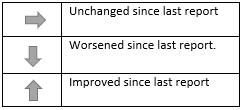
|
|
|
Project/Programme
Title
|
Schedule
|
Risks*
|
Budget
|
Comment
|
Status
Change
|
|
1
|
Right
Tree Right Place Pilot
|
 
|
 
|
 
|
Partnership
agreement with The Nature Conservancy has been confirmed, and their project
manager has now been appointed. The media announcement about our partnership
has been well received with a number of follow-up articles requested. The
detailed project plan will be developed over the next six weeks. The shortage
of seedlings continues to pose a risk, due to limited availability.
|
Updated
since 29 Sep 21 SAR
|
|
2
|
Regional
Water Security Programme: Project 1: Heretaunga Water
Storage
|

|
  
|
 
|
Upper-Catchment
geotech investigations completed and draft report due end of October (approx
4-5 weeks lost due to Covid). Multiple engagements with Mangaroa Marae
representatives on lowland streamflow maintenance.
|
Updated
since 29 Sep 21 SAR
|
|
Project
2:
Managed Aquifer Recharge
|
 
|
 
|
 
|
Technical
workstreams steady. Mana whenua engagement for Cultural Impact Assessment
scheduled for 25 November. Landowner engagement and irrigation/landuse trial
options positive.
|
Updated
since 29 Sep 21 SAR
|
|
3
|
Ahuriri
Regional Park
|
 
|
 
|
 
|
New
dedicated project manager to be appointed by NCC. Project scope needs to be
fully defined with NCC. Focus for the next year is to clarify vision, scope,
and reconnect with Mana Ahuriri. Three Waters Reform may impact.
|
No
change
|
|
4
|
Clifton
to Tangoio Coastal Hazards Strategy Implementation
|
 
|
 
|
 
|
An
in principle decision for HBRC to take a leadership role in the
implementation of the strategy had been made subject to conditions. The
budget of 300k is insufficient for a full LTP amendment as long with other
workstreams.
|
No
change
|
|
5
|
On-demand
Public Transport
|
 
|
 
|
 
|
COVID
and other factors are adding further delays to the securing of buses which is
stretching out the trial launch by at least another 4 months. Additional
budget items have been identified and costed and being worked through the
HBRC budget process.
|
Updated
since 29 Sep 21 SAR
|
|
6
|
Kotahi
Plan
|
 
|
 
|
 
|
Project
Manager to be appointed. Te Mana o Te Wai – values and long-term
visions with tangata whenua due to start this year.
|
No
change
|
|
Kotahi:
Mohaka Plan Change
|
 
|
 
|
 
|
Workshop
with HBRC and NPDT project team delayed due to COVID, but still within
schedule.
|
No
change
|
|
7
|
Tukituki
Plan Policy Implementation
|
 
|
 
|
 
|
Two
tier N loss risk matrix developed with primary industry sector which will be
used to triage the Tuki consent applications. Engagement with community
recommenced after a hiatus due to Overseer uncertainty.
|
Updated
since 29 Sep 21 SAR
|
|
Farm
Environmental Management Plans (FEMPs)
|

|

|

|
First
cycle of FEMP resubmissions were due on 31st May 2021, currently awaiting
outstanding submissions which are delayed due to capacity of and number of
approved farm plan providers
|
Added
for 27 Oct 21 SAR
|
|
8
|
Financial
Upgrade Systems and Efficiencies (FUSE)
|
|
|
|
The
FUSE project is under review, as it is transitioning to BAU in order to
better manage the integration of Opal3 and Techone, and provide support
around the challenges around aligning financial data and internal process.
|
Updated
since 29 Sep 21 SAR
|
|
9
|
Te
Karamu Catchment Plan
|

|

|
N/A
|
New
FTE to be hired to manage this plan. There will be no specific budget
allocated, as this role will be considered operational. Currently behind
schedule to fill this position and commence development of plan.
|
Added
for 27 Oct 21 SAR
|
|
10
|
Ahuriri
Catchment Plan
|

|

|
N/A
|
New
FTE to be hired to manage this plan. There will be no specific budget
allocated, as this role will be considered operational. Currently behind
schedule to fill this position and commence development of plan.
|
Added
for 27 Oct 21 SAR
|
|
11
|
TANK
Plan Change
|

|

|

|
Budget
currently sitting at $4.5m spent to date. Unclear yet whether further caucusing is
required following the Hearing held 27 September with Ngāti Kahungunu Iwi Inc
(NKII) and Te Taiwhenua o Heretaunga (TToH).
|
Added
for 27 Oct 21 SAR
|
|
Tank
Plan Implementation
|

|

|

|
Comms
plan and pilot materials to be developed and tested.
|
Added
for 27 Oct 21 SAR
|
|
12
|
Erosion
Control Scheme (ECS) Programme (incl. Soil Conservation Nursery & HCEF)
|

|

|

|
Capacity
and capability, due to shortage in labour market and rising material costs
around farm planning.
|
Added
for 27 Oct 21 SAR
|
|
13
|
Water
Efficiency Programme Review (Future Water Use)
|

|

|

|
Funding
becomes available in Year 2 of LTP. Initial internal scoping undertaken and a
brief of work for policy development options to direct funding has been
approved. Policy document to be reviewed internally before being
presented to Council.
|
Added
for 27 Oct 21 SAR
|
|
14
|
Ecosystem
Prioritisation: Terrestrial
|

|

|

|
Jobs
for Nature (J4N) funding has increased number of sites that will be protected
over the next three years
|
Added
for 27 Oct 21 SAR
|
|
Ecosystem
Prioritisation: Coastal & Marine
|

|

|

|
No
allocated budget or resources for implementation of science report findings.
To be reviewed next Long Term Plan cycle.
|
Added
for 27 Oct 21 SAR
|
|
15
|
Partial
Possum Control Plan Review
|

|

|

|
Cost
Benefits Analysis is underway, and detailed project plan is being developed.
If Council decide to approve the proposal in Jan 2022, a risk
assessment for contractor capacity and maintaining a fit-for-purpose
contractor market will be required.
|
Added
for 27 Oct 21 SAR
|
|
16
|
Flood
Control & Drainage Scheme – IRG: Heretaunga Flood Control &
Drainage Scheme & Upper Tukituki Flood Control Scheme)
|

|

|

|
Risks
being managed are resource availability (consultants and contractors),
COVID-19 programme delays, archaeological findings may cause delay
|
Added
for 27 Oct 21 SAR
|
|
Flood
Control & Drainage Scheme – IRG: Upper Tukituki Flood Control
Scheme
|

|

|

|
Risks
being managed are market engagement, achieving targeted extraction volumes
within allocated budget, COVID-19 programme delays
|
Added
for 27 Oct 21 SAR
|
|
Flood
Control & Drainage Scheme – IRG: Wairoa River, River Parade Erosion
|

|

|

|
Risks
being managed are COVID-19 programme delays, procurement of materials,
unforeseen ground conditions, cultural impact assessment
|
Added
for 27 Oct 21 SAR
|
|
17
|
Revenue
& Financing Policy/ Rates Review (incl. Scheme Rating Reviews)
|

|

|

|
This
project has not started, and will commence upon the appointment of new CFO
|
Added
for 27 Oct 21 SAR
|
|
18
|
Enterprise
Asset Management
|

|

|

|
This
project is due to commence in Feb 2022
|
Added
for 27 Oct 21 SAR
|
Project Summaries
|
1
|
Right Tree Right
Place
Pilot on up to five
farms to understand the detail set-up costs, partnership, and delivery
options. Under the trial, we would offer a loan to landowners to plant trees
on their erodible land. Opportunities being explored with The Nature
Conservancy.
|
|
2
|
Regional Water
Security Programme
PGF funding
has allowed us to investigate water supply options through two projects:
Heretaunga Water Storage and Managed Aquifer Recharge in Central
Hawke’s Bay. A 50-year Regional Water Assessment will inform the work,
including regional water supply and demand into a future challenged by
climate change.
|
|
3
|
Ahuriri Regional
Park
Working alongside NCCC
to redevelop the Lagoon Farm site into a Regional Park will allow for
stormwater detention and wetland treatment for improved environmental
outcomes, as well as providing cultural, educational, and recreational
opportunities.
|
|
4
|
Clifton to Tangoio
Coastal Hazards Strategy Implementation
Working with HDC &
NCC to implement the long-term (100 year) adaptive strategy for responding to
coastal erosion and coastal inundation in priority areas of the coast between
Clifton and Tangoio.
|
|
5
|
On-Demand Public
Transport
A new form of public
transport that replaces fixed routes with an on-demand service. This will be
a trial in Hastings which uses innovation and technology to lower the
region’s transport emissions, provide better transport choices for the
community and will give more equitable access to public transport.
|
|
6
|
Kotahi
Is a combined resource
management plan for the Hawkes Bay region. The Regional Policy Statement and
Regional Plan combined, and the Regional Coastal Environment Plan are due for
review. In addition, the NPSFM 2020 requires us to develop a plan to
give effect to Te Mana o Te Wai.
|
|
7
|
Tukituki Plan Policy
Implementation
Implementation
of statutory deliverables related to the Tukituki Plan, with particular focus
on changes arising from the Government’s response to the Science
Advisory Panel’s review of Overseer.
Farm
Environmental Management Plans (FEMPs)
FEMPs aim to
address environmental outcomes and actions to improve environmental performance
on properties over 4ha within the Tukituki region at this stage 3 yearly
submission cycle – first resubmission was due 31 May 2021
|
|
8
|
Financial Upgrade
Systems and Efficiencies (FUSE)
The
implementation of the new financial system TechOne. FUSE will standardise
processes, and improve transparency and accessibility of financial data, and
financial process efficiencies.
|
|
9
|
Te Karamu Catchment
Plan
The new plan will
collate intelligence on all parties and their activities in the Karamu
Catchment. This will be utilised to provide visibility on activities within
the catchment and identify options to influence for improved water quality
and biodiversity outcomes.
|
|
10
|
Ahuriri Catchment
Plan
The new plan will
collate intelligence on all parties and their activities in the Ahuriri
Catchment. This will be utilised to provide visibility on activities within
the catchment and identify options to influence for improved water quality
and biodiversity outcomes.
|
|
11
|
TANK Plan Change
(Policy)
Proposed TANK Plan
Change (PPC9) will add new
rules to the Regional Resource Management Plan to manage water quality and
quantity for the Tūtaekurī, Ahuriri, Ngaruroro and Karamū
(TANK) catchments.
TANK Plan Change
(Implementation): TANK Subcatchments Community Engagement
An external comms
project, intended to inform rural landowners about the PC9 framework and to
promote catchment group formation. It is a precursor to the overall PC9
Implementation, the latter contingent on a decision awaited from Hearings
Commissioners and any subsequent appeals.
|
|
12
|
The Erosion Control
Scheme (ECS)
Provides access to a
grant for Hawke's Bay landholders to implement soil conservation measures on
highly erodible land, keeping soil on the hills and out of waterways. It
provides significant financial support for erosion control work such as
non-commercial tree planting, protection fencing, land retirement and
assisted reversion.
Hill Country Erosion
Fund (HCEF)
Is Central Government
funding to support ECS activities and events that are targeted at educating
and supporting staff and landowners with the reduction of hill country
erosion.
Soil Conservation
Nursery
The primary purpose of
the nursery is to grow poplar and willow poles for erosion control and are
managed primarily for the ECS and Works Group, river control plantings.
|
|
13
|
Future Water Use
‘Future Water
Use’ – making better use or the water we have to complement water
storage. Work with water users to drive more efficient and effective use to
complement water storage.
|
|
14
|
Ecosystem
Prioritisation:
Terrestrial
This
programme focuses on protecting and enhancing 700 Ecosystem Prioritisation
sites across the region. To achieve this, we have partnered with internal and
external stakeholders alongside land occupiers. The main actions are deer
fencing, pest plant and animal control and some enhancement planting.
Ecosystem
Prioritisation: Coastal and Marine
The Coastal and Marine
team have undertaken scientific investigations to identify biodiversity
prioritisation sites off the coast of Mahia and Clive, using Zonation
software to inform spatial management. The outcomes and recommendations have
been concluded and can now move forward to implementation phase.
|
|
15
|
Partial Possum
Control Plan Review
Investigating changing
the current Possum Control Area Programme from an occupier responsibility
model to a large-scale contract model. A contracting model will secure the
continued success long term of the outcomes delivered by low possum numbers
and increase the biodiversity benefits from consistently low possum numbers.
|
Enforcement Actions
|
|
24. There are 11 active
prosecutions before the court, at various stages therefore not able to
comment publicly on.
|
|
Date
|
Type of Enforcement Action
|
Status
|
|
Feb
21
|
Discharge
to land that may enter water
|
Before
the court
|
|
Jan
21
|
Discharge
to air - odour
|
Before
the court
|
|
Nov
20
|
Burning
prohibited items
|
Before
the court
|
|
Nov
20
|
Discharge
to land that may enter water
|
Before
the court
|
|
Oct
20
|
Burning
prohibited items
|
Before
the court
|
|
Jul
20
|
Discharge
to land that may enter water
|
Before
the court
|
|
Jun
20
|
Burning
prohibited items
|
Before
the court
|
|
Jun
20
|
Discharge
to land that may enter water
|
Before
the court
|
|
Jun
20
|
Discharge
to land that may enter water
|
Before
the court
|
|
Mar
20
|
Discharge
to land that may enter water
|
Before
the court
|
|
Jun
19
|
Burning
prohibited items
|
Before
the court
|
Environment Court Processes
|
|
Date
|
Type of Enforcement Action
|
Status
|
|
Oct
20
|
Outstanding
Water Bodies Plan Change appeals
|
Mediation
date confirmed for 27 October
|
|
|
Draft
Water Conservation Order application for Ngaruroro River appeals
|
Before
the court
|
Decision Making Process
2. Staff have assessed the requirements of the Local Government Act
2002 in relation to this item and have concluded that, as this report is for information
only, the decision-making provisions do not apply.
Recommendation
That the Hawke’s Bay Regional Council
receives and notes the “Significant Organisational Activities Looking
Forward through November 2021” staff report.
Authored by:
|
Michael
Bassett-Foss
RTRP Project Manager
|
Allan Beer
Team Leader Biosecurity - Animal Pests
|
|
Sarah Bell
Team Leader Strategy & Performance
|
Jack Blunden
Team Leader Compliance - Urban &
Industrial
|
|
Vicki
Butterworth
Cycle Network Coordinator
|
Desiree Cull
Strategy & Governance Manager
|
|
Peter Davis
Manager Environmental Information
|
Tania Diack
Team Leader Consents
|
|
Ben Douglas
Forest Management Advisor
|
Ceri Edmonds
Manager Policy and Planning
|
|
Russell
Engelke
Team Leader Open Spaces
|
Dean Evans
Manager Catchments Delivery
|
|
Craig Goodier
Principal Engineer
|
Martina
Groves
Manager Regional Assets
|
|
Sandy
Haidekker
Senior Scientist
|
Nathan Heath
Area Manager Northern Hawke's Bay
|
|
Dr Andy Hicks
Team Leader/Principal Scientist Water
Quality and Ecology
|
Rob Hogan
Manager Compliance
|
|
Gavin Ide
Principal Advisor Strategic Planning
|
David
Keracher
Manager Regional Projects
|
|
Dr Kathleen
Kozyniak
Principal Scientist (Air)
|
Campbell
Leckie
Manager Catchment Services
|
|
Anna
Madarasz-Smith
Team Leader/Principal Scientist Marine &
Coast
|
Julie-Anne
McPhee
Senior Project Manager
|
|
Malcolm
Miller
Manager Consents
|
Mark Mitchell
Team Leader Principal Advisor Biosecurity
Biodiversity
|
|
Te Wairama
Munro
Maori Engagement Coordinator
|
Tim Norris
Land Scientist
|
|
Thomas Petrie
Programme Manager Protection &
Enhancement Projects
|
Brendan
Powell
Manager Catchments Policy Implementation
|
|
Wendy
Rakete-Stones
Acting Team Leader Plant Pests
|
Dr Jeff Smith
Manager Science
|
|
Jolene
Townshend
Senior Advisor Integrated Catchment
Management
|
Belinda
Harper
Senior Planner
|
Approved by:
|
Katrina
Brunton
Group Manager Policy & Regulation
|
Chris Dolley
Group Manager Asset Management
|
|
Iain Maxwell
Group Manager Integrated Catchment
Management
|
|
Attachment/s
There are no
attachments for this report.
HAWKE’S BAY REGIONAL COUNCIL
Māori
Committee
Wednesday 03 November 2021
Subject: Discussion of Minor
Items not on the Agenda
Reason for Report
1. This document has been prepared to assist committee members note the
Minor Items to be discussed as determined earlier in Agenda Item 8.














































